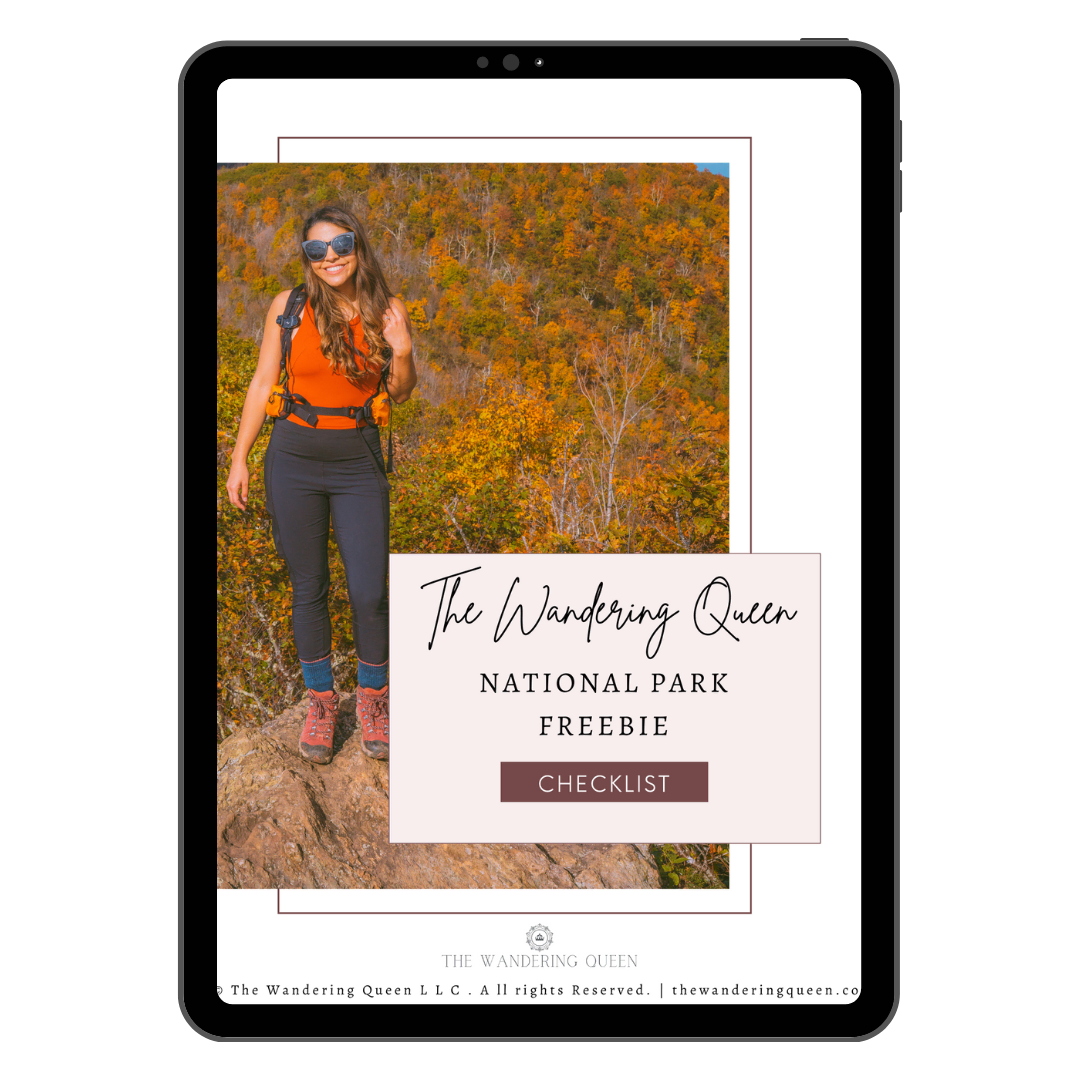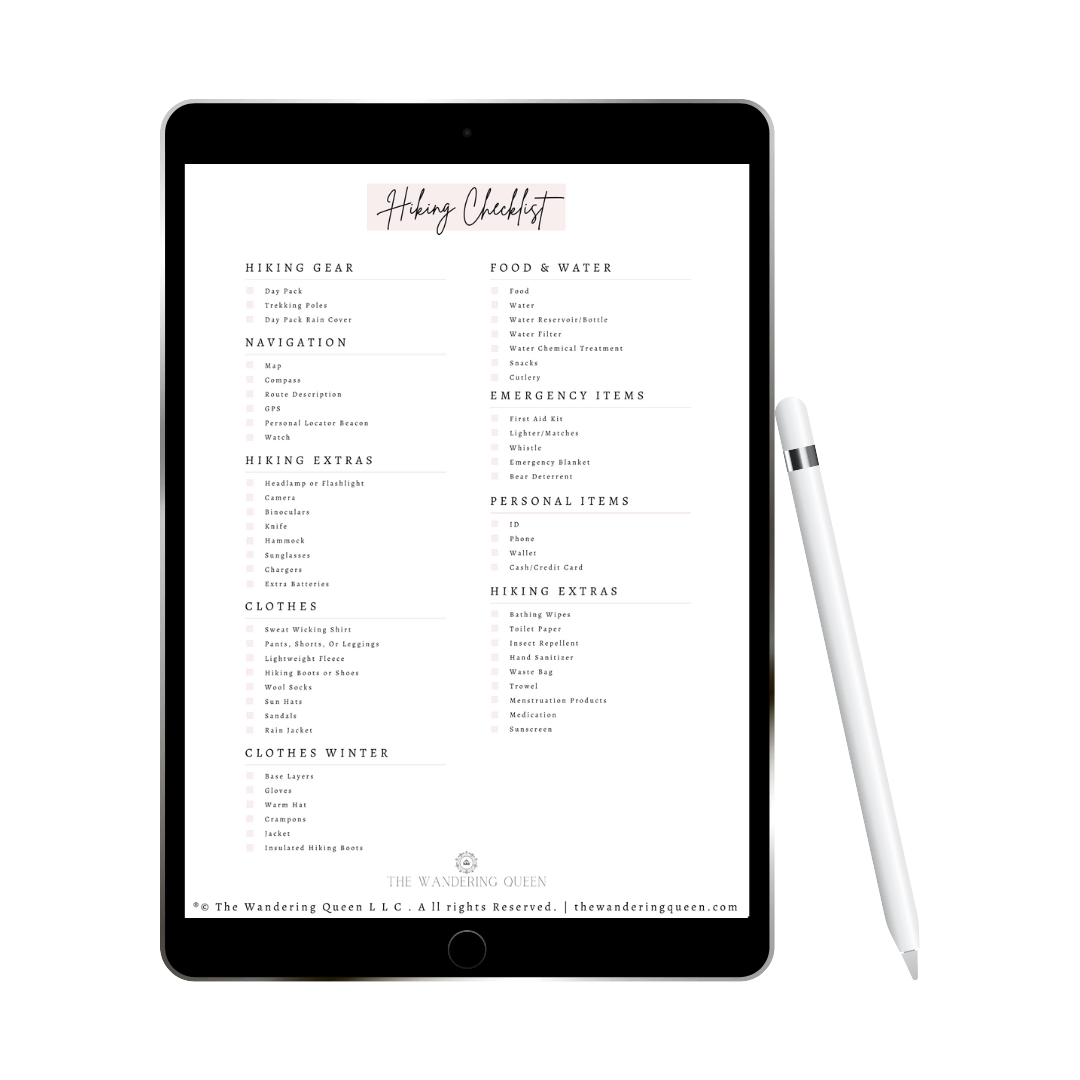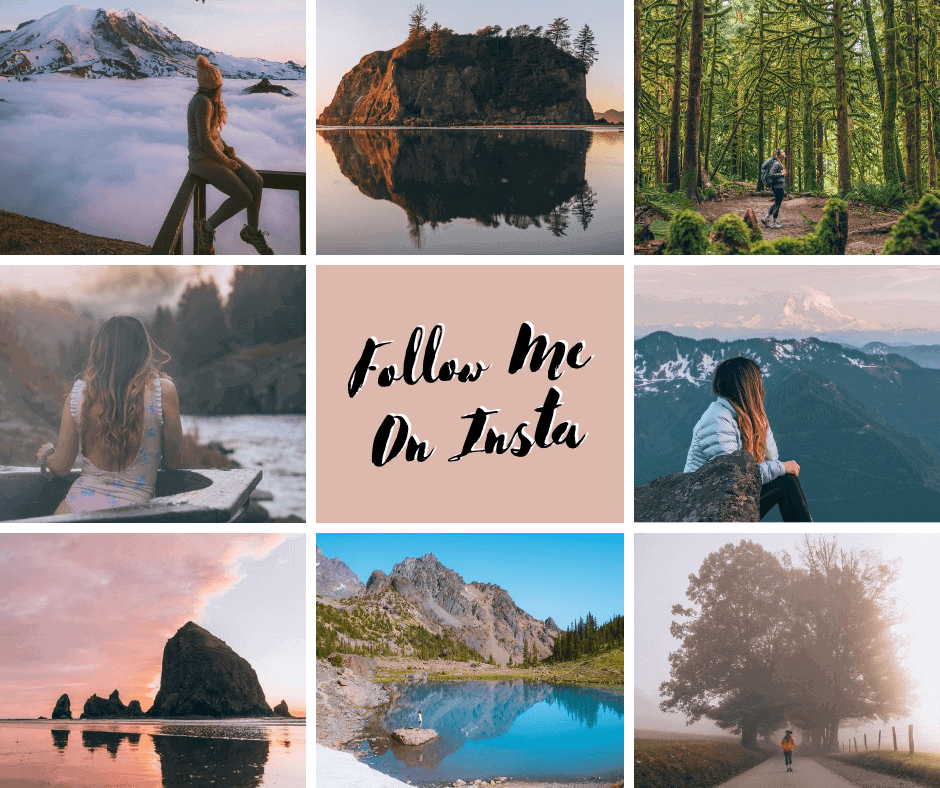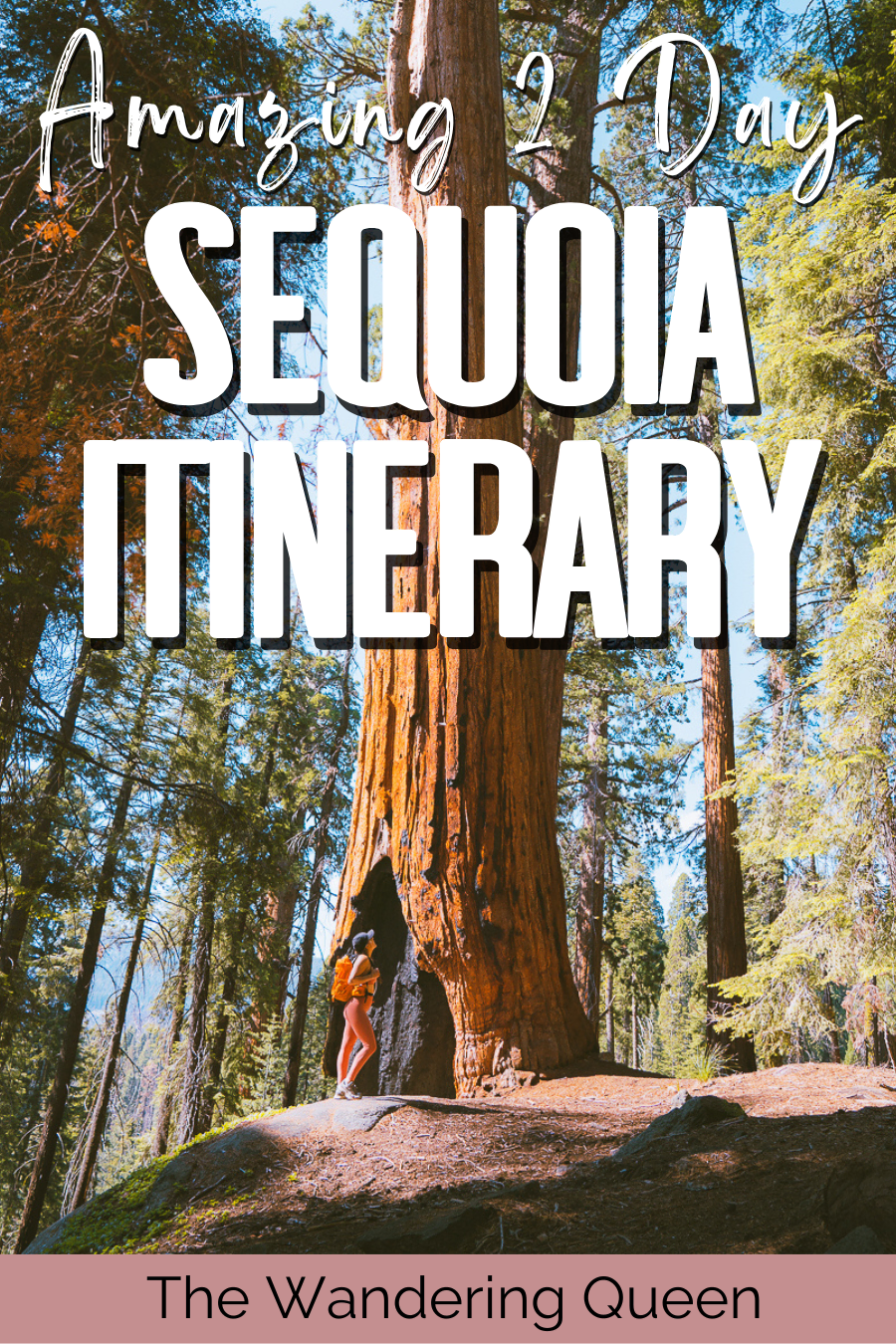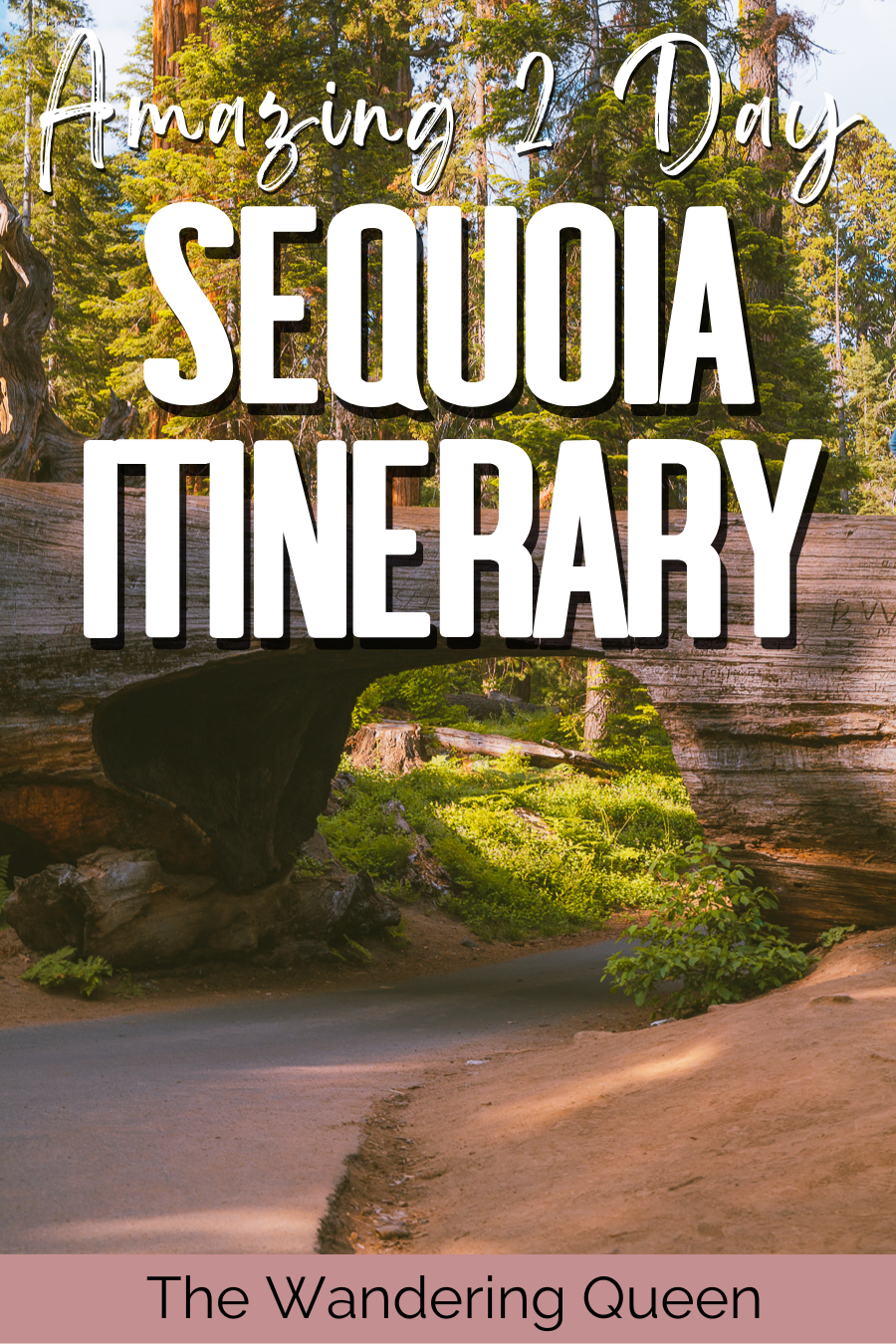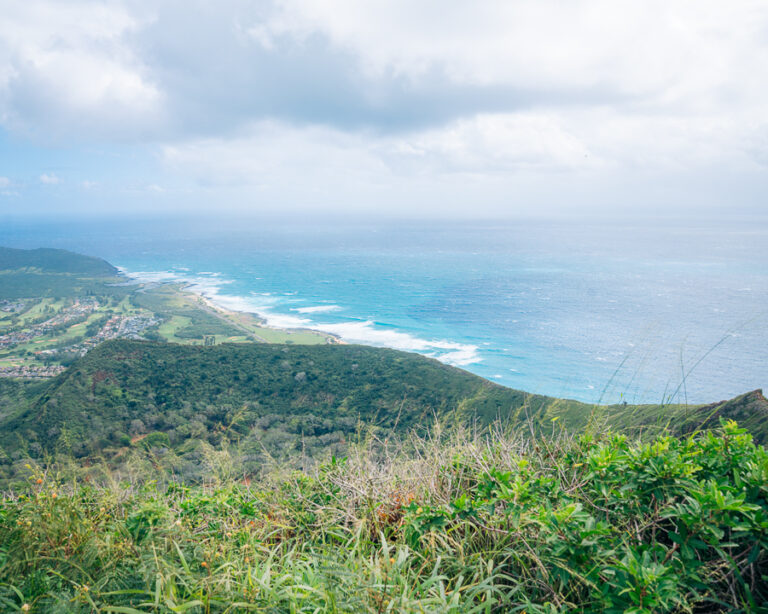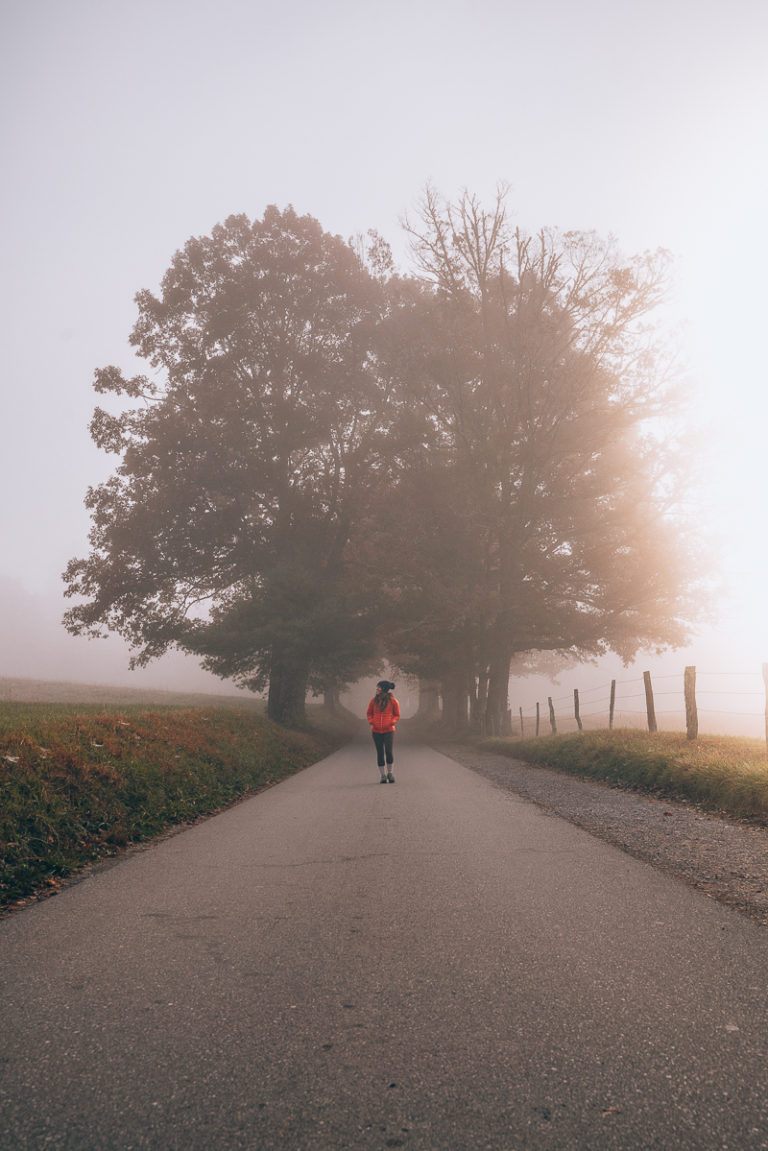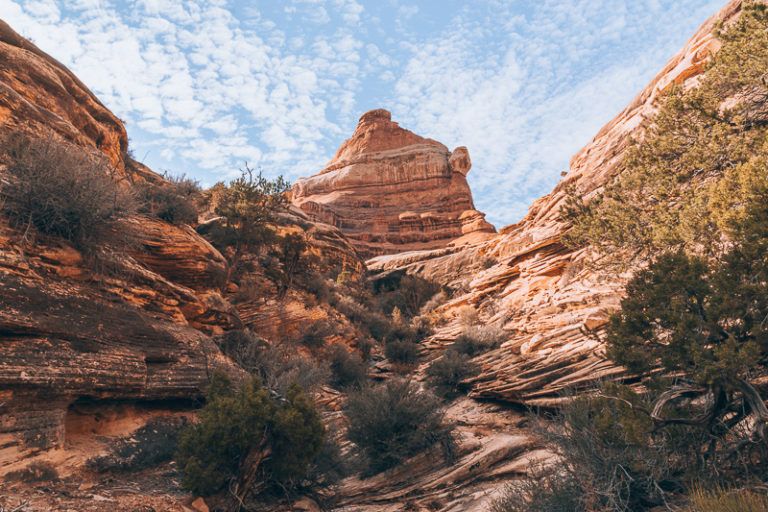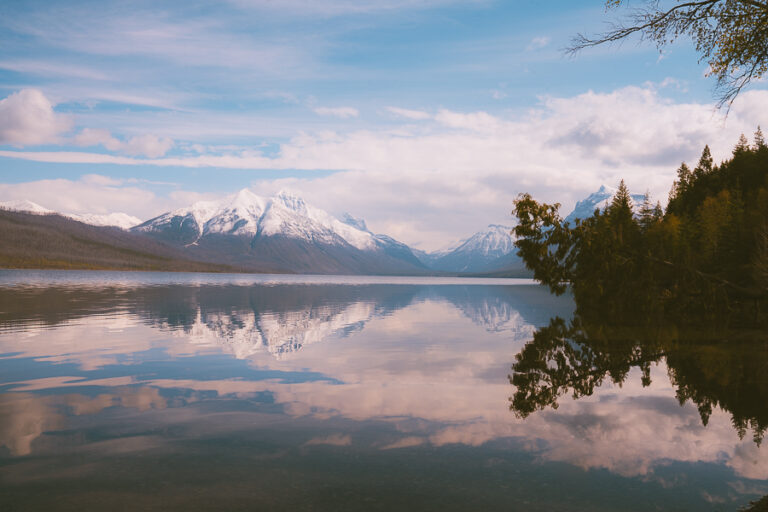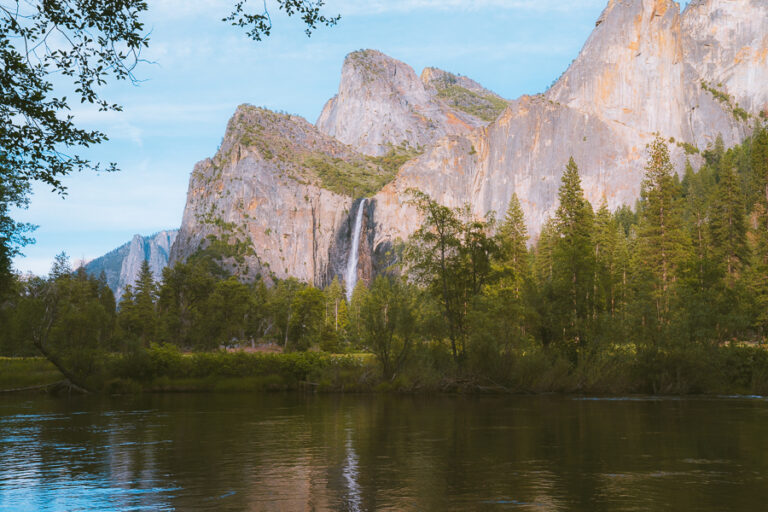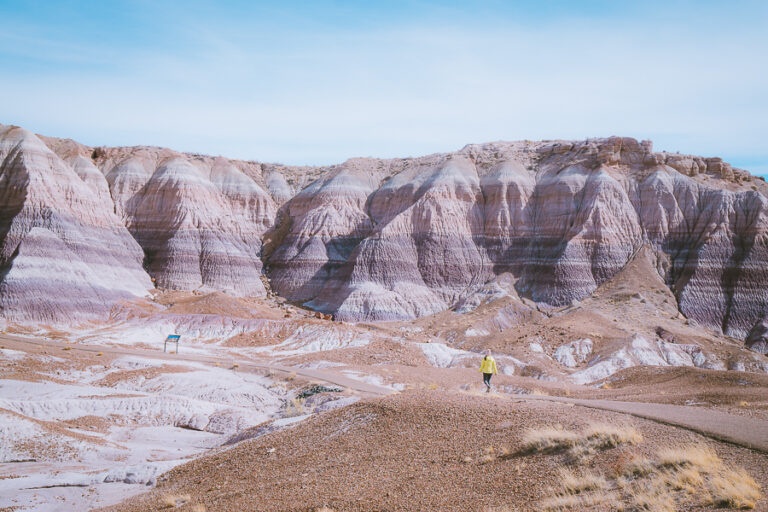Sequoia National Park Itinerary + Kings Canyon
On your way to Sequoia? You’ve landed at the right place if you’re not sure how to plan a trip to Sequoia National Park.
Visiting such a vast and remote space filled with towering mountains, deep canyons, rugged foothills, and the world’s largest trees is no easy feat. What to see first? What do you pack? When should you go? Where will you stay?
With this Sequoia National Park itinerary, you’ll get all your answers and valuable insights to plan your trip down to the last detail. After all, preparation is key to having an unforgettable time in the great outdoors.
So, keep reading for some tips and a smashing two-day itinerary involving the Kings Canyon National Park as well. Call yourself a tree-hugger because it’s time to embrace the giant sequoias!
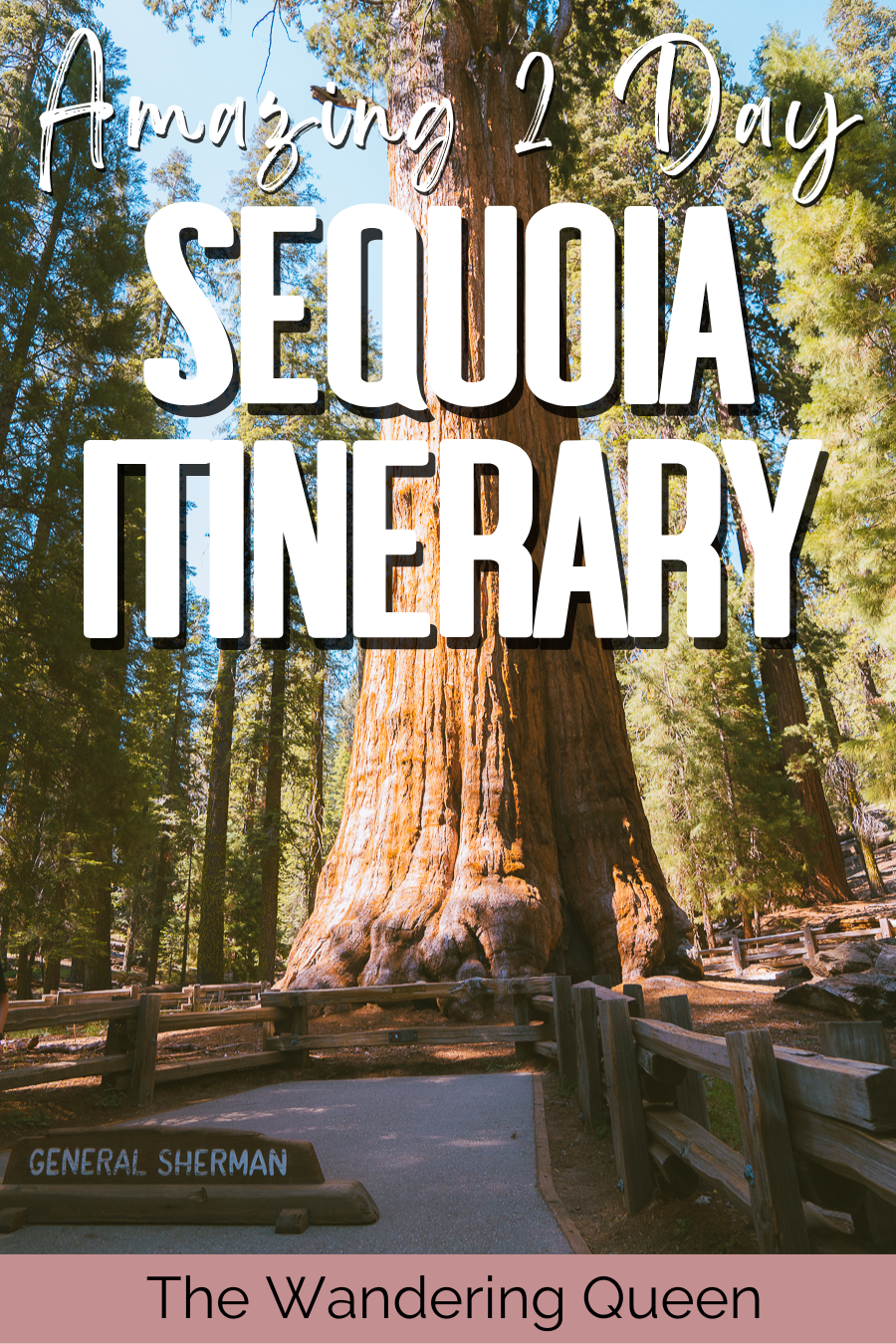
Disclosure: This post contains affiliate links. If you click one of them, I may receive a small commission (for which I am very grateful for) at no extra cost to you.
SEQUOIA National Park
Related Posts
Map Of Sequoia National Park Itinerary
You can copy and download the itinerary below, but I recommend printing it because you can’t see it if you have no service.
How To Get to Sequoia National Park
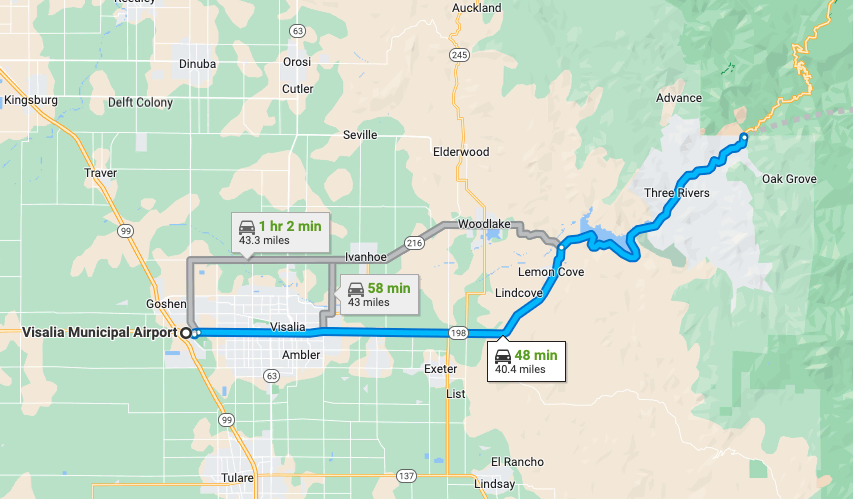
Go onto Highway 198 through Visalia city and stick to this road as it leads east to Sequoia National Park via Three Rivers. Highway 198 also serves as the Generals Highway, which connects 198 to 180, taking you to Kings Canyon.
Best Time To Go to Sequoia National Park
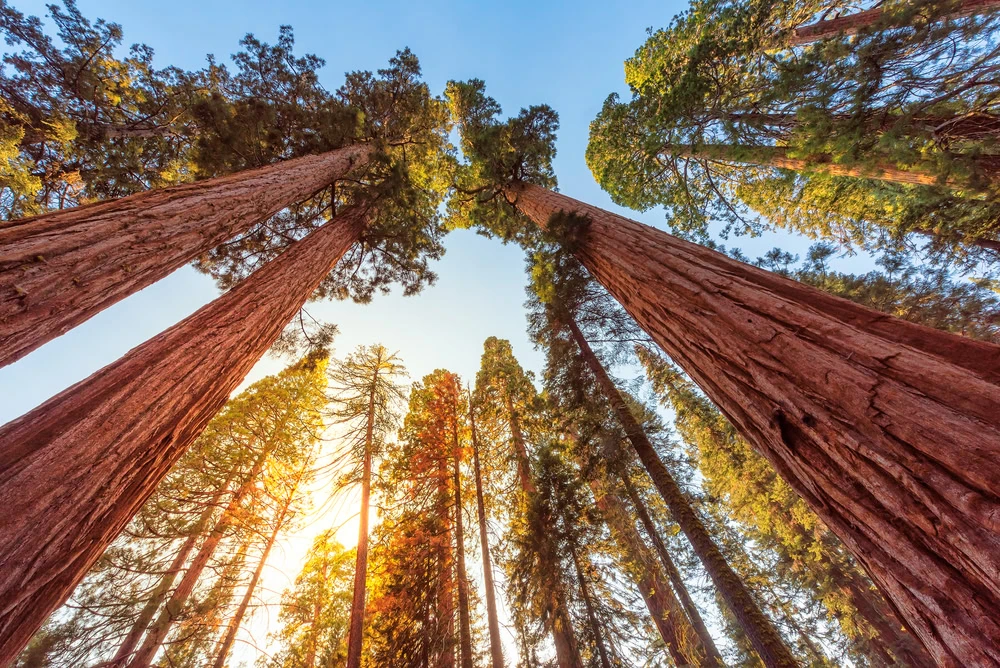
The most exhilarating time to visit Sequoia National Park is hands down, June through August. This falls under the summer season, and the park will be busy since it’s a popular time to visit.
However, the fantastic (and stable) weather makes up for the busy atmosphere. You can pick up any activity without worrying about closures and stormy conditions.
It’s best to visit the Sequoia Park complex during springtime for the most breathtaking wildflower viewing. Blooming in all kinds of vibrant hues, flowers begin to adorn the meadows in April through to mid-June. You can also witness the mighty sequoias thrive and verdant grasses spring to life.
Tips for Planning a Trip to Sequoia National Park
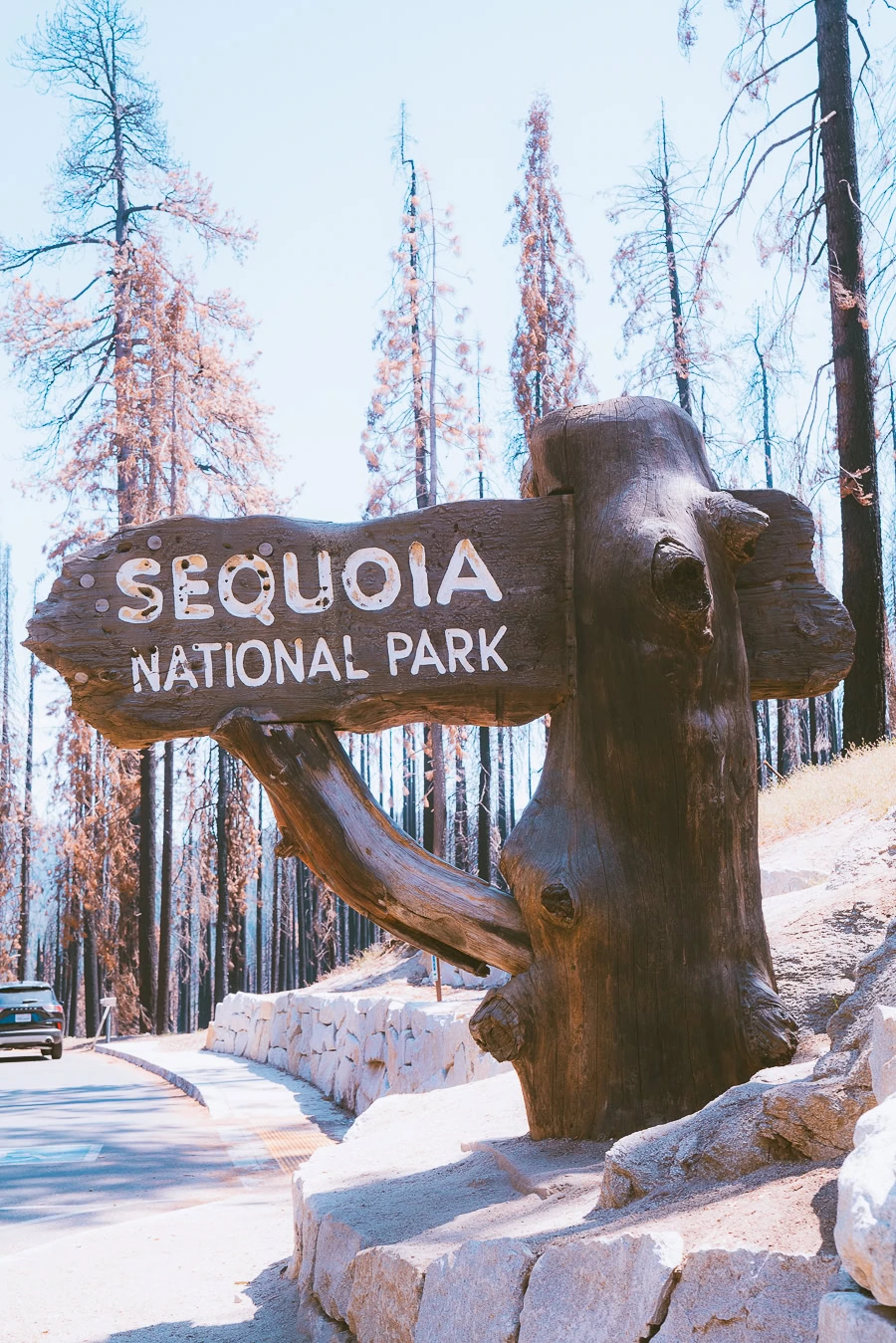
Did you know Sequoia National Park covers 404,064 acres of forested mountainous terrain? And it’s also home to more than 300 diverse species of wildlife. Going there won’t be a walk in the park, especially if you’re unprepared.
Fret no more. The following (excellent) tips will prepare you to take on Sequoia and King Canyons like a pro.
Visitor Centers
Sequoia offers a mix of visitor centers, ranger stations, and wilderness permit stations to help you navigate the park. Below are the main visitor centers.
Foothills Visitor Center
You’ll locate this visitor center on the General Highway about one mile north of the Ash Mountain Entrance. Come to this center if you want to explore the Sierran foothills, the park’s most biologically diverse area. Crystal Cave tour tickets are sold here and open daily between 8 AM and 4:30 PM.
Lodgepole Visitor Center
This visitor center is also located on the General Highway but is just a bit further away from the Ash Mountain entrance (about 21 miles). It’s two miles north of the General Sherman Tree, and here you’ll learn about the history of the southern Sierra Nevada. Lodgepole is open daily from 9 AM to 6 PM and is closed during winter.
The Giant Forest Museum
Technically not a visitor center, the Giant Forest Museum is a great place to pop in before going about your park adventures. Just one hour north of the Ash Mountain Entrance, this historic museum building has been around since 1928. Renowned architect Gilbert Stanley Underwood initially designed the museum as Sequoia National Park’s original market.
Visit the Giant Forest Museum all year round, daily between 9 AM and 6 PM in summer and 9 AM to 4:30 PM in winter.
Cedar Grove Visitor Center
While this is in Kings Canyon, it makes sense to include it if you visit this park as well. The center is located right next to the South Fork of the Kings River. Here, you’ll find a restroom, park information, parking, water, and a telephone.
It’s currently inaccessible due to winter road closures but is expected to open on 05/01/2024. It’s open daily between 9 AM and 5 PM.
What To Pack for Sequoia National Park
Here’s what to pack for your trip to Sequoia National Park:
- Warm layers: Pack warm, insulating layers and waterproof jackets to stay dry during winter. For more guidance, here’s a helpful winter hiking gear checklist.
- Comfortable footwear: Keep your feet comfy and blister-free by wearing sturdy hiking boots.
- Water and snacks: Stay hydrated and well-nourished for the hikes in the park.
- Sunscreen/sun protection: Protect your skin with a high SPF sunblock and a sunhat.
- First-aid kit: Be prepared for any misstep or incidents while exploring with an outdoor emergency kit.
- Camera: Take some gorgeous snaps for the socials with a good-quality camera.
- Backpack: Carry a lightweight backpack to keep all the essentials on you.
- Snowshoes: If you’re visiting in winter, you’d want to wear waterproof snowshoes to tread through snow.
- Insect repellent: Avoid having sleepless nights by using a good bug spray.
- National Park Pass: I highly recommend getting a year-long America The Beautiful Pass so you can get into both parks with ease. >Get It Here
- Map And Trail Guide: Start planning your trip with this. >Buy One Here
Claim your FREE Hiking Checklist
Ready to start hiking? Grab my free hiking checklist and never forget anything at home!
Weather Forecast and Closures
Generally, you can expect the weather in Sequoia National Park to be cold in the evening and warm in the daytime. However, it can change drastically depending on the elevation and where you are in the park. With a variation of 20-30 degrees, as you change elevation, you can see spring flowers in the foothills and snow in the Giant Forest in one visit.
The winter season in Sequoia (December to March) sees temperatures between 15.8 – 37.4°F. While it becomes a magical winter wonderland blanketed in snow, it’s also prone to winter storms and road closures.
The warmer months are easier to visit, and summer is the high season of both Sequoia and Kings Canyon. Falling between mid-June and August, the summer season welcomes sunny days with average temperatures between 37.4 – 71.6°F.

Pro Tip: Keep up with daily weather forecasts to prepare well.
Wildlife to Look Out For
Sequoia National Park is an oasis for life, so the abundance of wild animals calling it home should be no surprise. Big horn sheep, bears, wolverines, coyotes, deer, beavers, and many more critters graze this park. This means visitors should respect their homes, keep a safe distance (especially from mothers with their young), and explore with caution.
As a result, you should carry bear spray with you, keep your pup leashed, and be observant of your surroundings.
Camping in Sequoia National Park
Sequoia and King Canyons National Parks offer various campgrounds for every adventurer, including dispersed, primitive sites, developed campgrounds, and group camping. Standard sites (up to six) cost $32, mid-size groups go for $50, and $60 – $80 for large-group campsites.
Safety Tips and Precautions
Here are a few more safety tips:
- Always inform friends or family before hiking and ensure they know roughly how long it will take you to complete it.
- Pop in at a visitor center or ranger station before entering the park.
- There are “dead spots” throughout, so you won’t always have a signal. In that case, download a map on your phone or print one to take with you.
- Ensure your cell phone is fully charged before you go, and take a power bank if you’re planning to spend hours in the park.
- Don’t wander off the marked trails.
Where to Stay Near Sequoia National Park
If one day isn’t enough for you, then opt for accommodation in cities near Sequoia National Park to plan a multi-day trip. Below are some of the best options for hotels.
Budget | Quality Inn Lone Pine
Stay near Sequoia without splurging on accommodation at the Quality Inn Lone Pine. Located near Mount Whitney, this pet-friendly three-star hotel has all the amenities and modern comforts you need for a cozy stay. The rooms are simple and neat, with clear views of the eastern Sierra Nevada Mountains and an outdoor swimming pool.
Wake to a delicious breakfast, including waffles, fresh fruit, and cereal. Then, enjoy the flat-screen TV, coffee machine, and air conditioning, among other amenities. >>>Check Availability
Mid-Range | Views Views Views!
If the name didn’t give it away, this humble yet elegant abode is all about its dazzling lake and mountain vistas. Views Views Views! has many large windows and a breezy patio, allowing you to admire the landscape from the comfort of a couch or chair.
With three bedrooms, a spacious living room, and a fully-kitted kitchen, it can entertain a family or group. The location makes you feel tucked away in a tranquil wilderness with many outdoor activities around you, like hiking, skiing, and fishing. Refresh in the walk-in shower, grab a book in front of the cozy fireplace, or relax on the terrace. >>>Check Availability
Luxury | Secluded Mountain Top Home
Live in the lap of luxury as mountainous scenery and serene skies grace you. This Secluded Mountain Top Home is nothing short of lavish, with four stars behind its name. The spacious rooms are elegant and modest, with a modern black-and-white bathroom.
Light up the BBQ on the vast patio and take in the peaceful sweeps courtesy of the Sequoia mountains and the Three Rivers region. Amenities include air conditioning, Wi-Fi, BBQ facilities, and a fully-equipped kitchen. The home has two bedrooms and two bathrooms, ideal for a small group or family. >>>Check Availability
2-Day Sequoia and Kings Canyon Itinerary
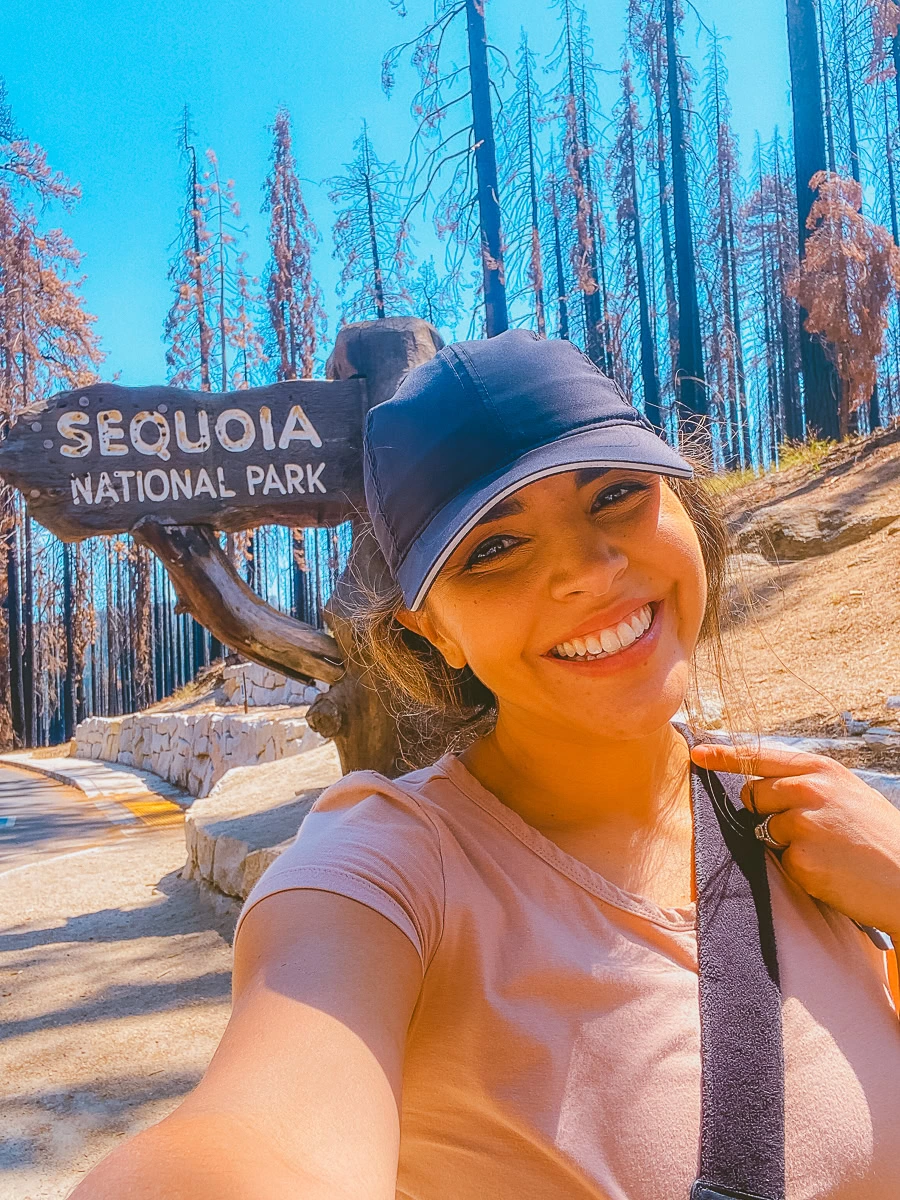
Here’s the ideal two-day Sequoia and Kings Canyon National Park itinerary to experience the best of both parks.
Day One: Sequoia National Park
Day one starts in Sequoia, so arrive early to get in as many activities as possible. Better yet, try coming the day before so you can rest well before taking on this massive park. Here are some of the most unmissable attractions and things to do.
1. Hike to Moro Rock
- Mileage: 0.49 miles (out-and-back)
- Elevation Gain: 183.7 feet
- Difficulty: Moderate
- Trail Guide: Link
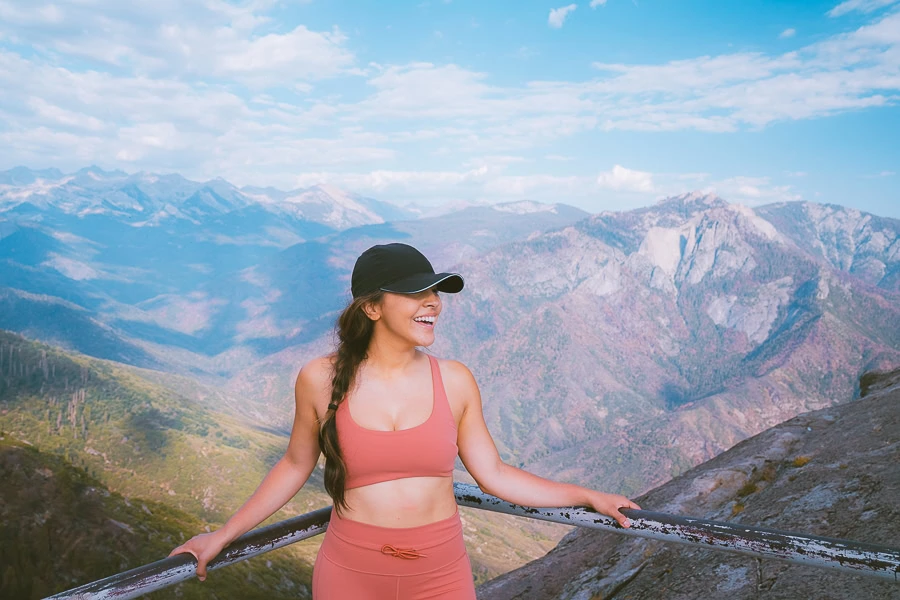
Start your day with a quick and moderate hike to one of the most distinctive granite dome rock formations in Sequoia. You’ll feel refreshed and warmed up to take on the entire park after this trek. Taking about 20 minutes to complete, you won’t believe how gorgeous the panoramic vistas are from Moro Rock.
Since it’s the first thing on the agenda, it allows you to catch the dreamy sunrise. This usually takes place between 6 and 7 AM, depending on what season you’re visiting.
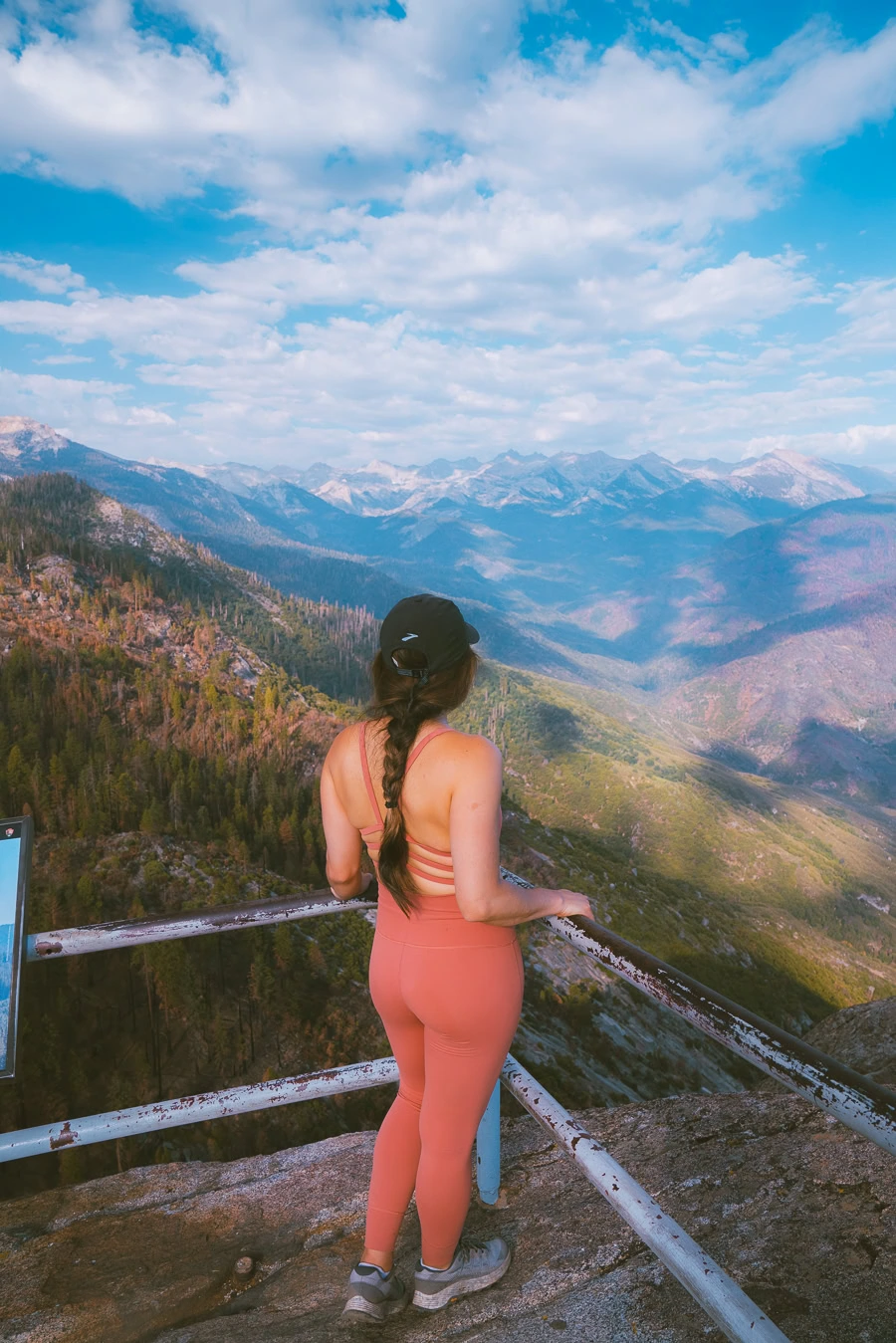
The hike is near Hartland, CA, starting at the Moro Rock parking area. You’ll get to the parking area via a road from Giant Forest Museum, which offers free shuttles in summer. You can’t access this road on weekends, so taking a shuttle is the only way to reach Moro Rock.
The climb up the stairs to the top of this geological wonder is not for the faint-hearted. You’ll crisscross between boulders and creep along narrow ledges that may induce acrophobia. But, as always, the sight of foothills, San Joaquin Valley, and endless wilderness is worth it.
2. Parker Group Sequoias
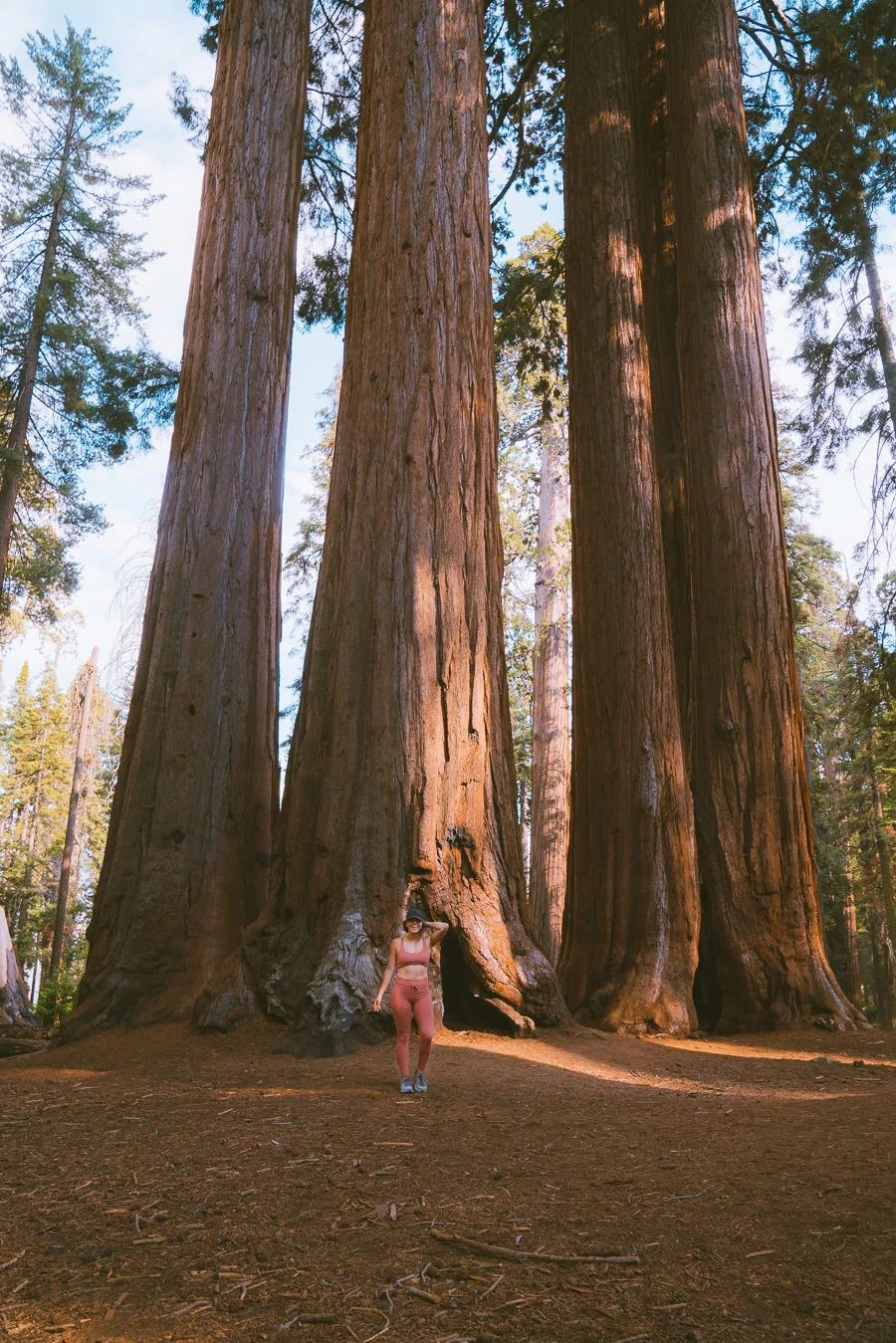
Next is a trip to the Parker Group Sequoias along Crescent Meadow Road. It’s a family of majestic giant sequoia trees named after the group that first stumbles upon these beauties. It’s a great little spot for photography and to cool off from the sun for an obvious reason: the trees offer plenty of shade. Plus, you’ll feel like an ant.
Also known as the Giant Forest, this piece of heaven sits in the heart of Sequoia National Park.

Fun Fact: It also boasts half of the top 10 largest trees in the world. You can visit these ancient behemoths from the Giant Forest Museum via a scenic drive or by picking up one of the various trails that wind through the forest.
3. Tunnel Log
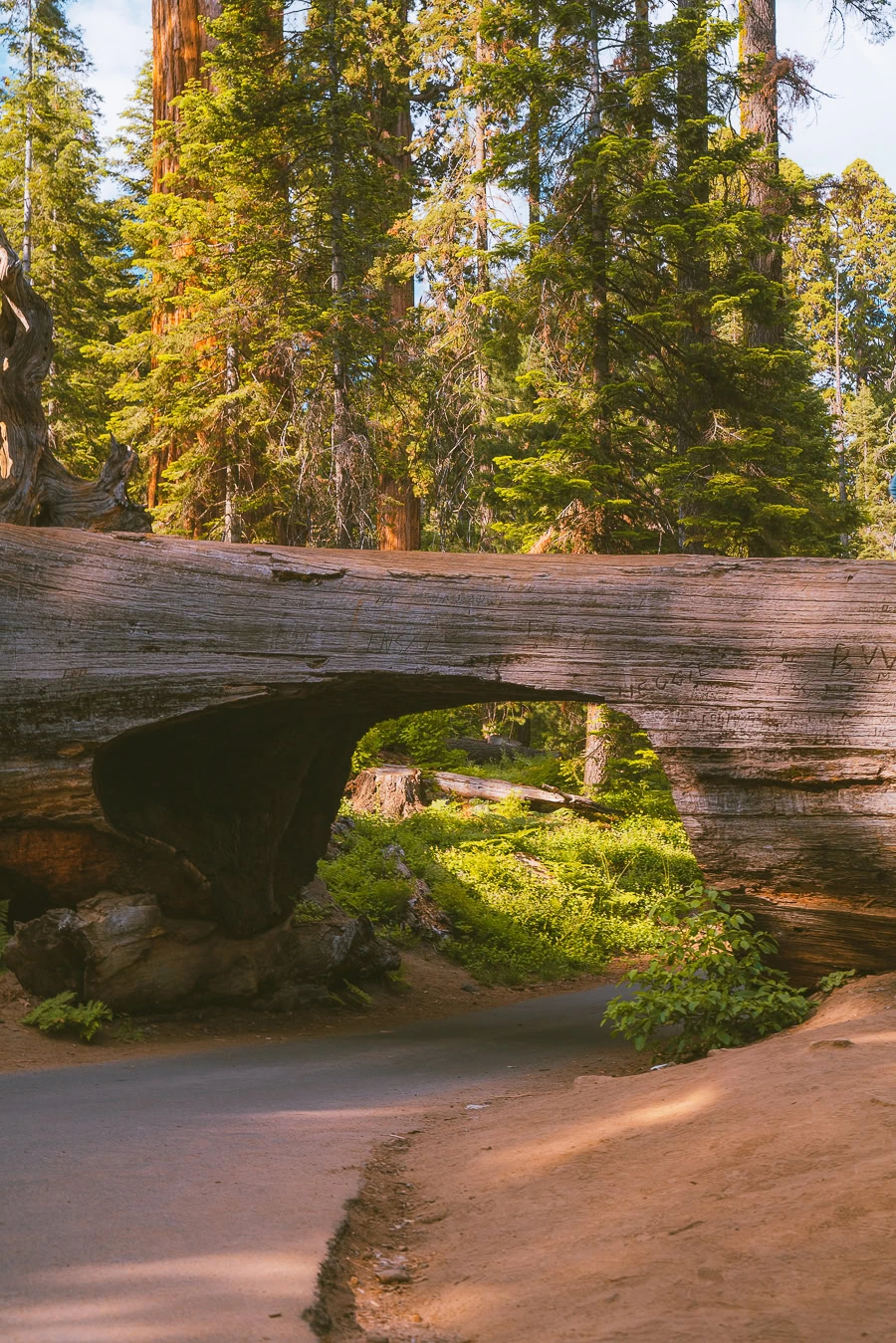
One of the most unique and memorable things you can do in Sequoia is to drive under a gigantic fallen tree.
This magical tunnel is located along Crescent Meadow Road in Giant Forest. The tunnel was carved in 1938 out of the trunk of a sequoia tree that fell over in 1937. This means that this once 275-foot-high (83.8 meters) tree is likely over 2,000 years old, including the time before it fell.
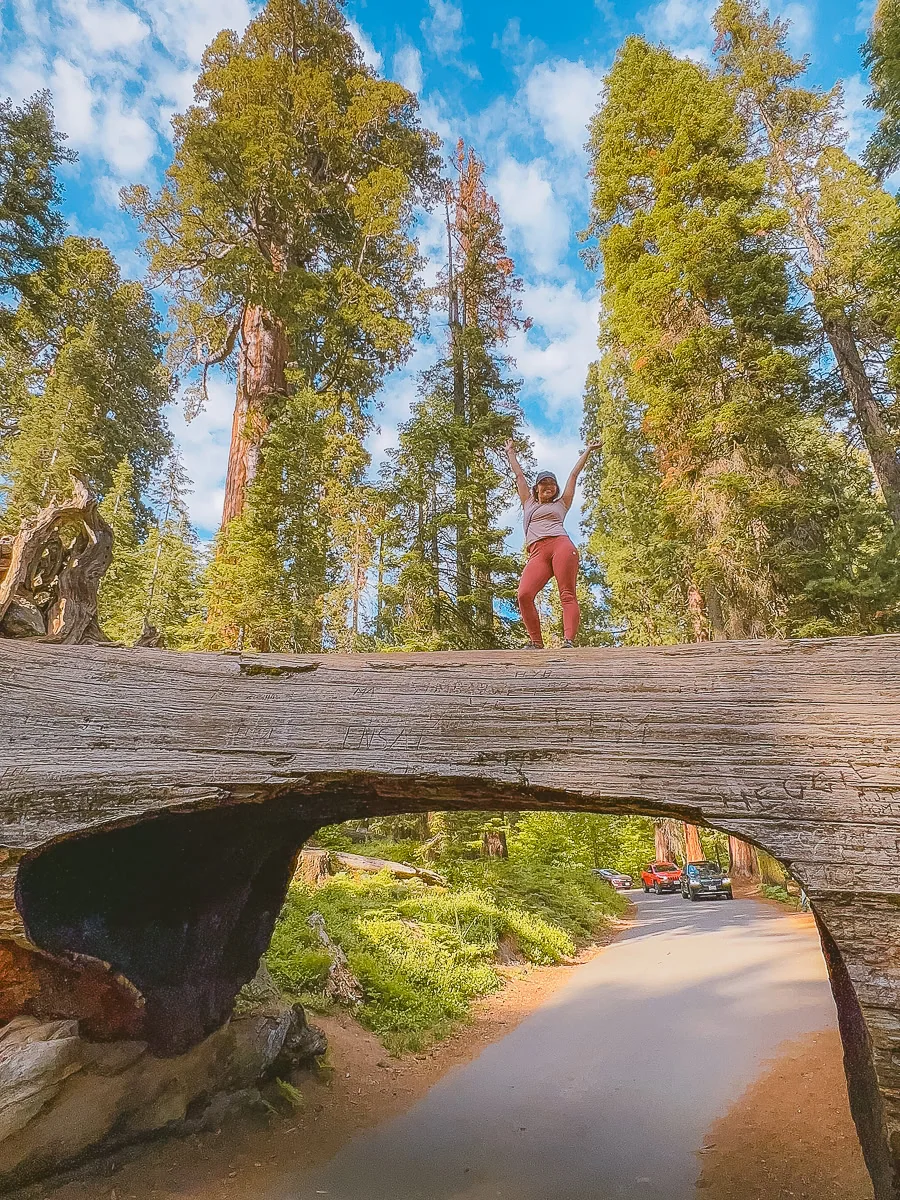
It’s a fairytale-like place where you can take some of the quirkiest photographs and even climb on the trunk.

Top Tip: If you’re doing well for time, before heading to General Sherman Tree, consider taking on the Big Trees Trail. This short and easy 1.2-mile hike starts near the Giant Forest Musuem and will take on half an hour to complete.
4. General Sherman Tree
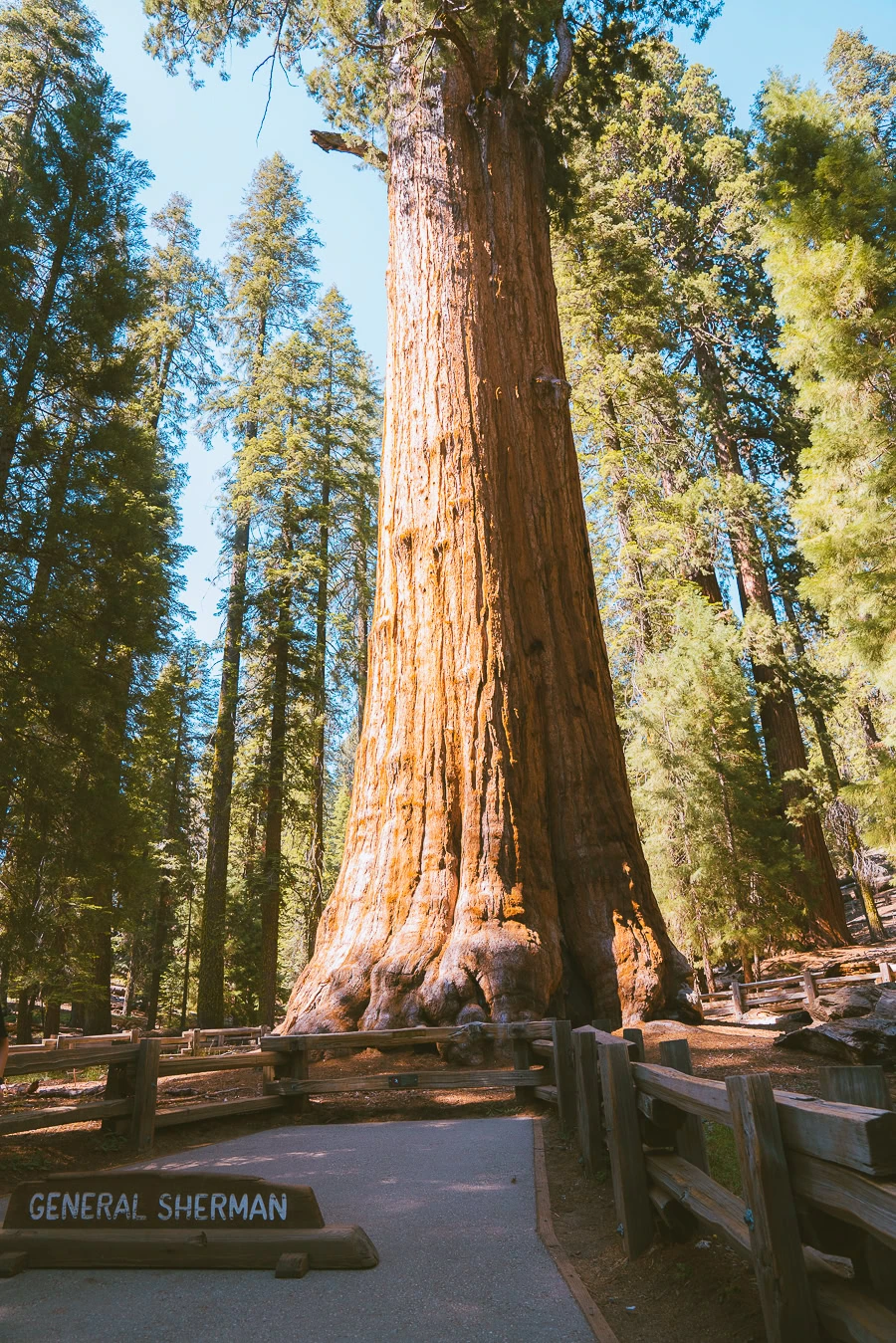
Standing proudly at the north end of Giant Forest is the biggest attraction in Sequoia National Park (literally). Carrying the title of the biggest tree on earth, this 2.7 million pound heavyweight champ is located at an elevation of 6,919 feet (2,109 m) above sea level.
So, here’s your opportunity to pose next to the most enormous tree! Here’s an idea: if you’re traveling with a group, wrap your arms around the trunk while holding hands for a stunning, adorable photo. The undisputed King of the Forest is thought to be between 2,300 and 2,700 years old, making you feel tiny and insignificant.
Two trails lead to the Sherman Tree. The main trail begins at the parking lot just off Wolverton Road and follows the signs. The second one starts at a small lot along Generals Highway, where you can park and follow a short, wheelchair-accessible trail.
5. Congress Trail
- Mileage: 2.9 miles (loop trail)
- Elevation Gain: 482 feet
- Difficulty: Easy
- Trail Guide: Link
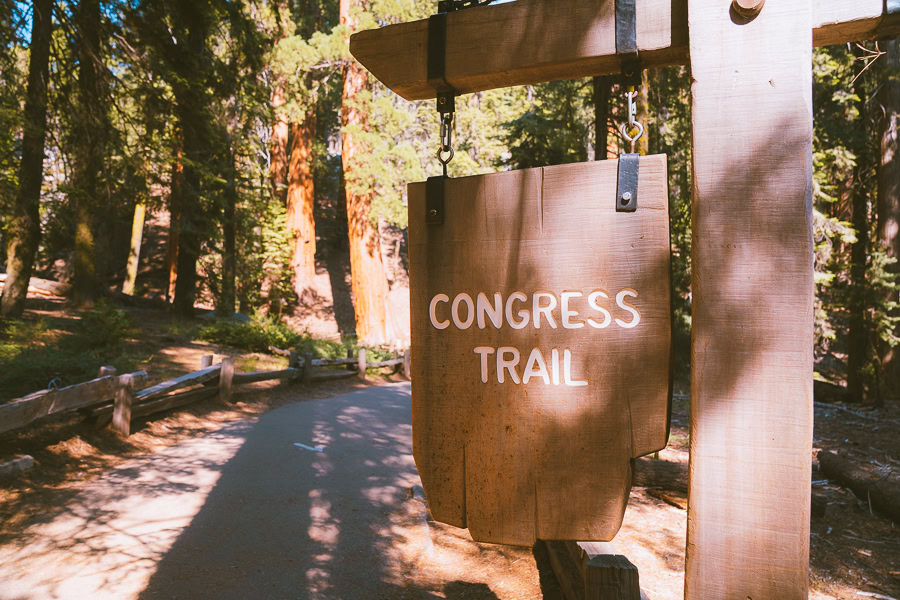
Now, after exploring the extraordinary Giant Forest, it’s time to wander off into new territory with an easy-peasy hike. Taking an average of one hour and 20 minutes to complete, you’ll meander through massive sequoias.
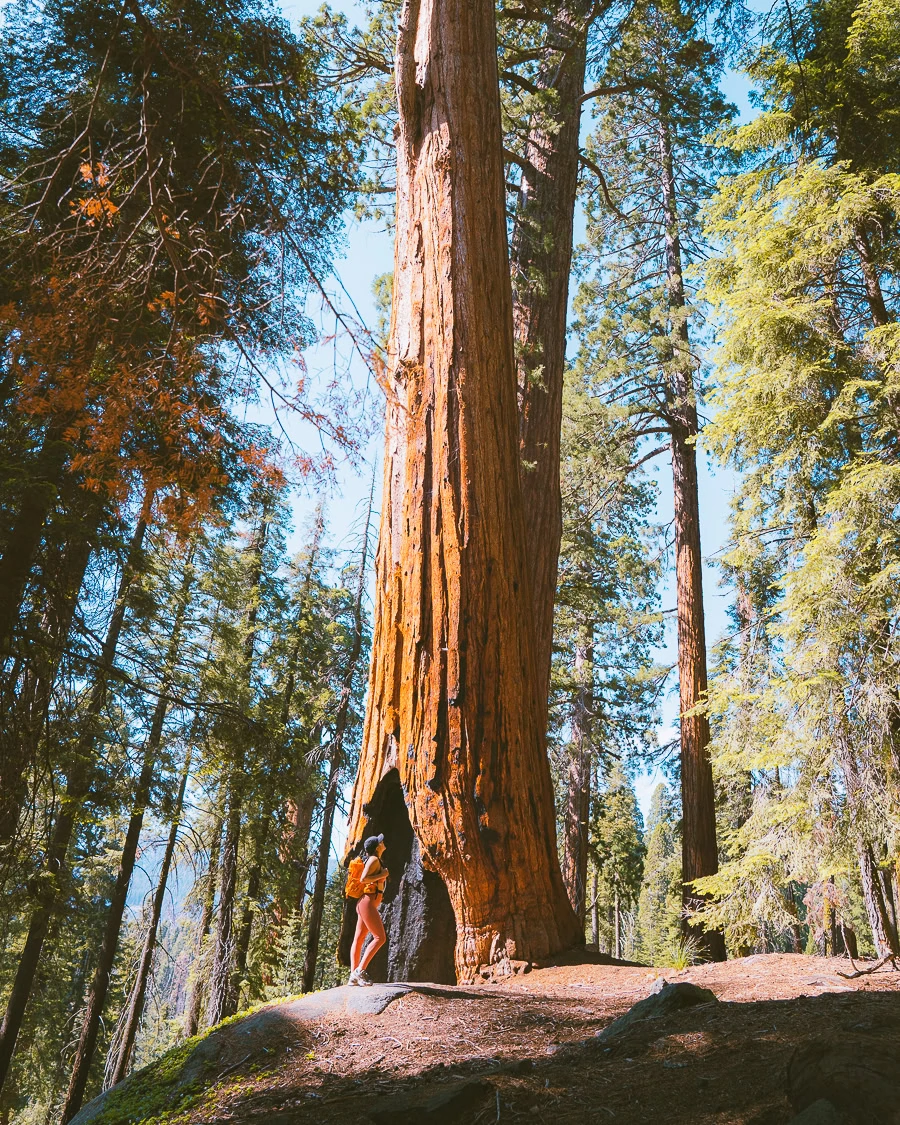
Shade will be abundant, and there are benches to rest and absorb the scenery along the way. You might even spot some wildlife in the distance. Due to heavy snowfall in winter, you may want to pack in some snowshoes and a trekking pole to help you navigate the thick snow.
The trail starts near the General Sherman Tree, so you can end your adventure in Sequoia with this hike.
Day Two: Kings Canyon National Park
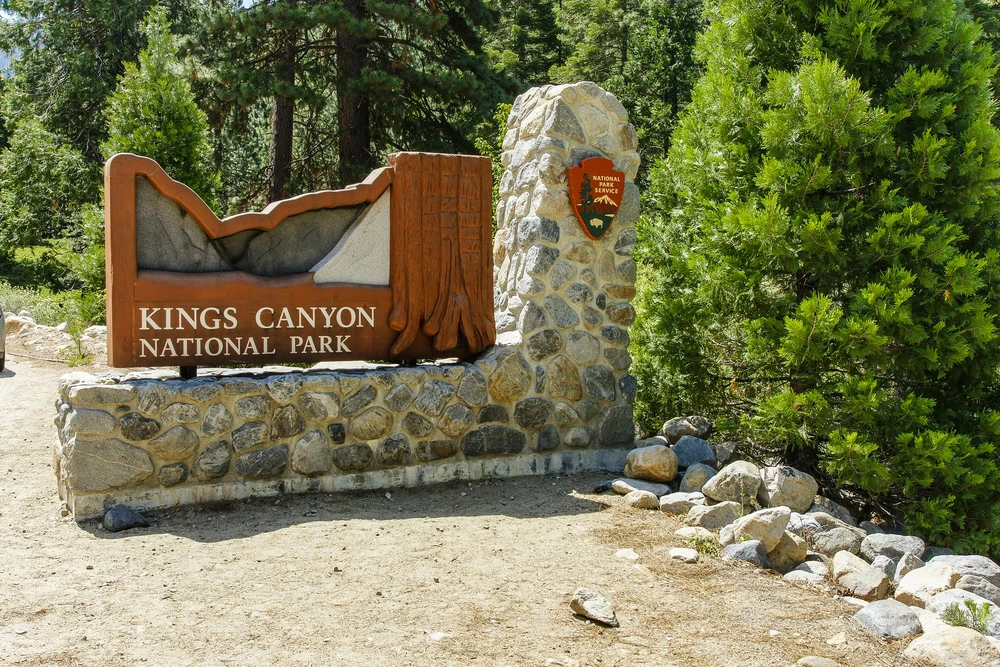
After getting to know Sequoia, it’s time to get acquainted with Kings Canyon. And here are the top sites and trails to consider.
1. Kings Canyon Scenic Byway
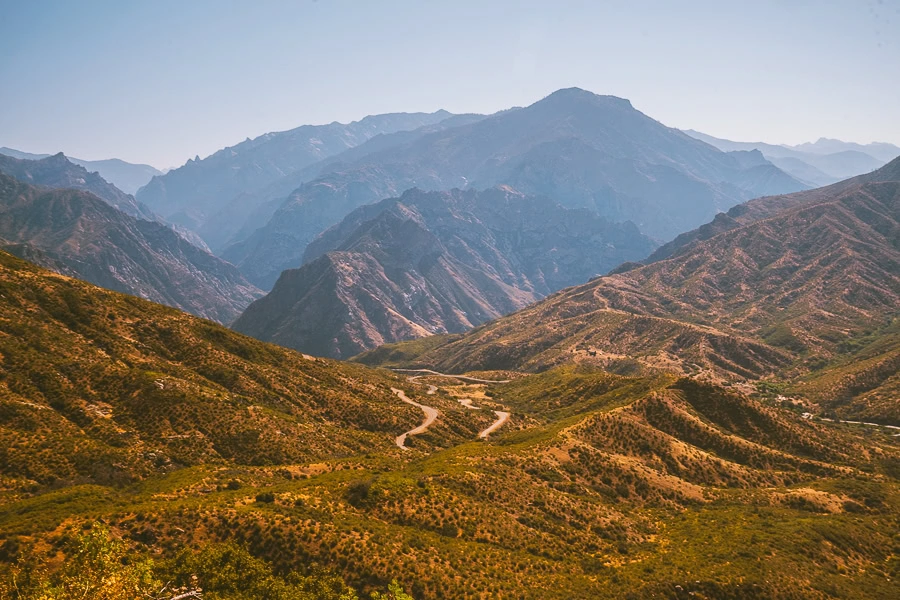
If you love a scenic drive, there’s no better place to start than the unmissable Kings Canyon Scenic Byway (one of California’s best). Located in Hume, Fresno County, the drive stars in the Sierra Nevada foothills near Dunlap. The byway stretches 50 miles along Highway 80 and leads to Roads End.
It eventually enters the Grant Grove area of Kings Canyon National Park and descends through Sequoia National Forest. Finally, you’ll end up in the Cedar Grove area of Kings Canyon. Traverse huge canyons and pass by waterfalls as the road follows along a river.
2. Zumwalt Meadows
- Mileage: 1.5 miles (out and back)
- Elevation Gain: 157 feet
- Difficulty: Easy
- Trail Guide: Link
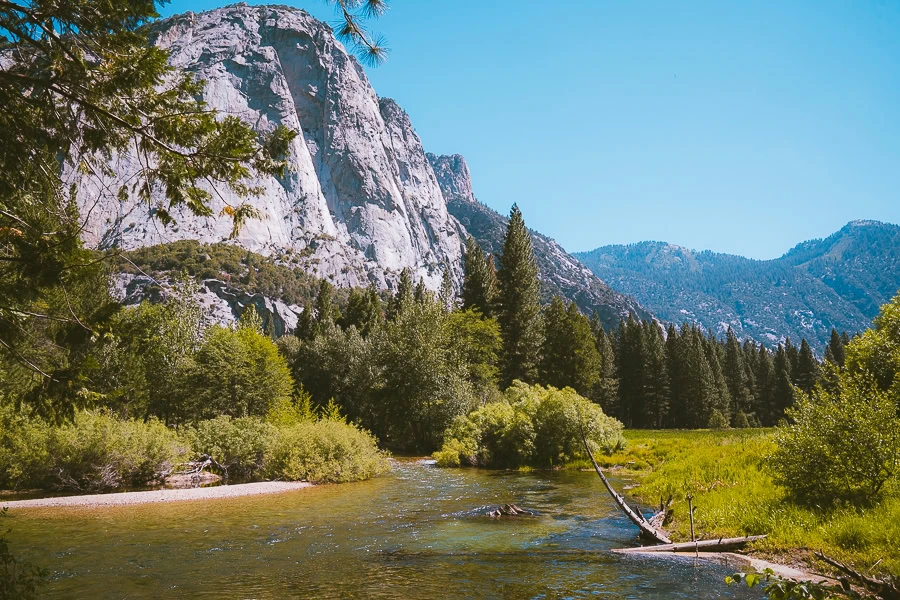
After a winding, scenic drive, it’s time to step out, stretch those legs, and tune in with nature. It’s a tranquil, picturesque meadow filled with lush greenery and enclosed by the Kings Canyon mountains.
This beautiful oasis offers magnificent sweeps of high granite walls and the free-flowing Kings River. You can reach it on the Zumwalt Meadow Trail, beginning near the Kings River. It crosses the riparian corridor and climbs along a rocky hillside.
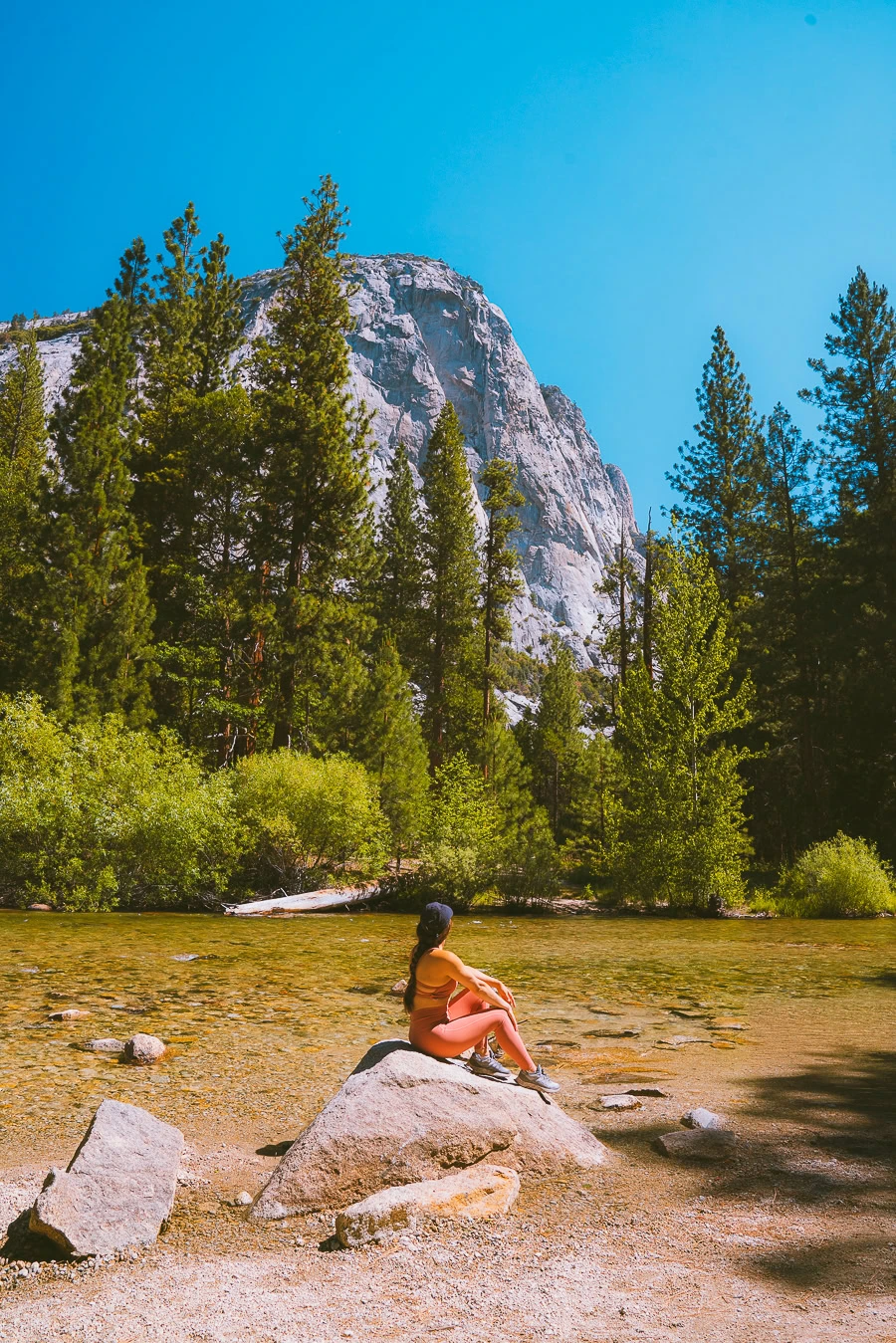
The meadow attracts bounds of park inhabitants, such as deer, bears, snakes, yellow-bellied marmots, and birds of prey. Note that Highway 180 closes in winter during mid-November, so you won’t be able to access it then.
new on the shop
The Ultimate Camping Trip Planner!
Our camping trip planner helps you stay organized and plan all aspects of your adventure so that you can conquer new territories with ease.
3. Boyden Cavern
Pop in at a gleaming marble cavern deep in the heart of the Kings Canyon. This remarkable cavern sits beneath the massive 2,000-foot-high marble walls of the famous Kings Gates. Boyden boasts a timeless environment of pendants, shields, flowstone, stalactites, and stalagmites.
You’ll take a brisk but steep hike to get to the cave, featuring breathtaking vistas of Kings Canyon along the way. A tour through the cavern suits all ages and last about 45 minutes to an hour — find out more about these on the Boyden Cavern website.
4. Ride Horses at Grant Grove Stables
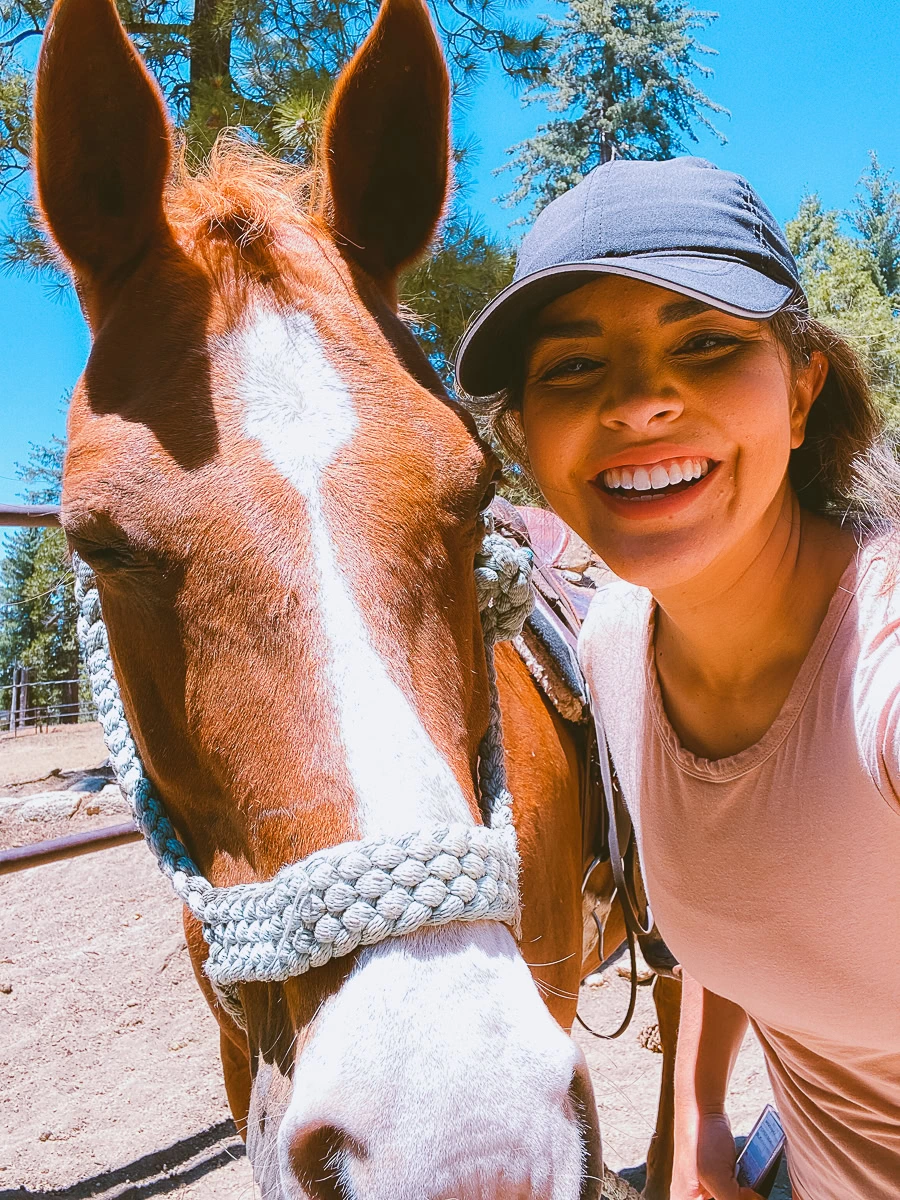
Tired of all the walking? Thought so, which is why riding a horse at the Grant Grove Stables is the perfect way to relieve those aching feet after exploring forests and caverns. Located in Hume, this family-owned business has been operating for over 27 years, providing one and two-hour guided trail rides by horseback.
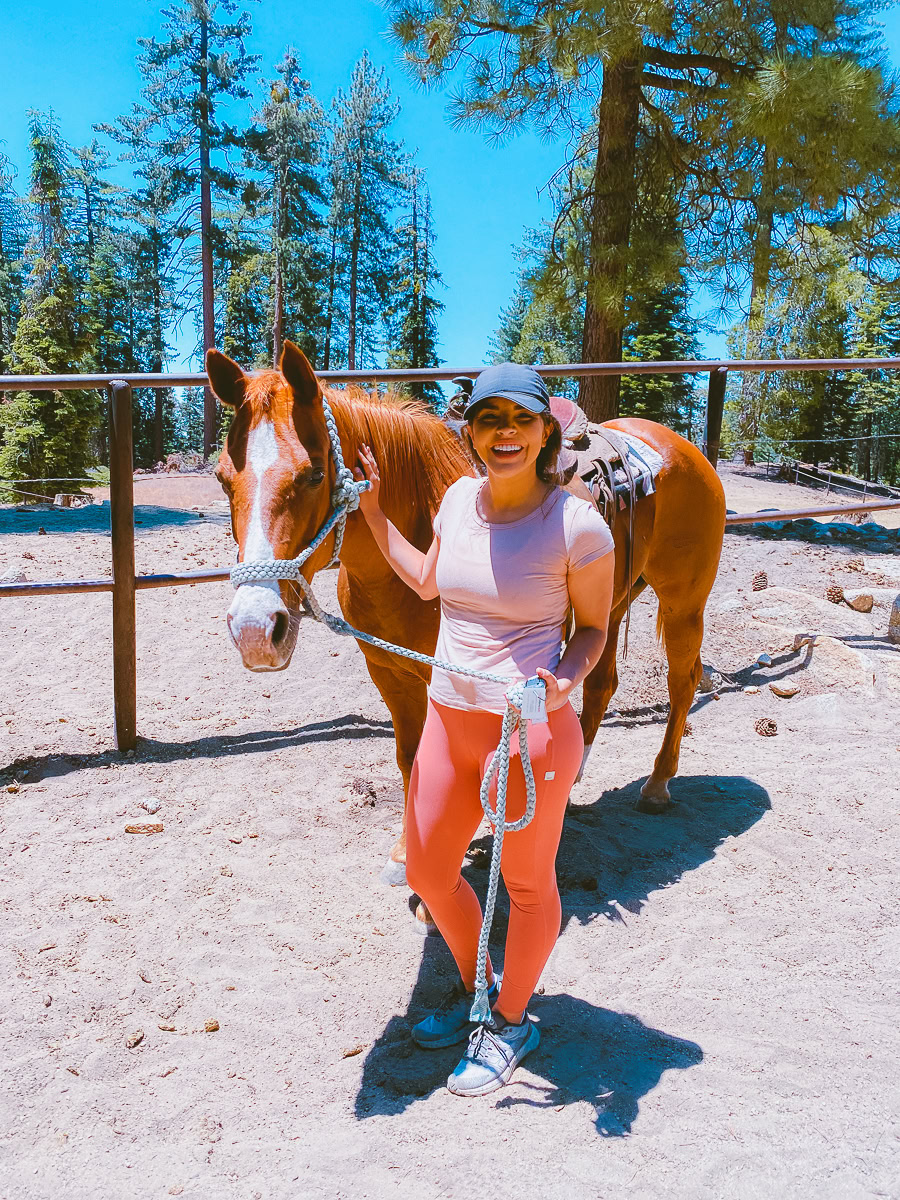
These guided horseback rides are available to the public in summer and may close or open depending on the weather conditions. Note that weight limits and age restrictions may apply, but you can phone (559) 335-9292 for more information and to make a reservation, as these are recommended.
5. General Grant Tree
- Mileage: 0.6 miles (loop trail)
- Elevation Gain: 32.8 feet
- Difficulty: Easy
- Trail Guide: Link
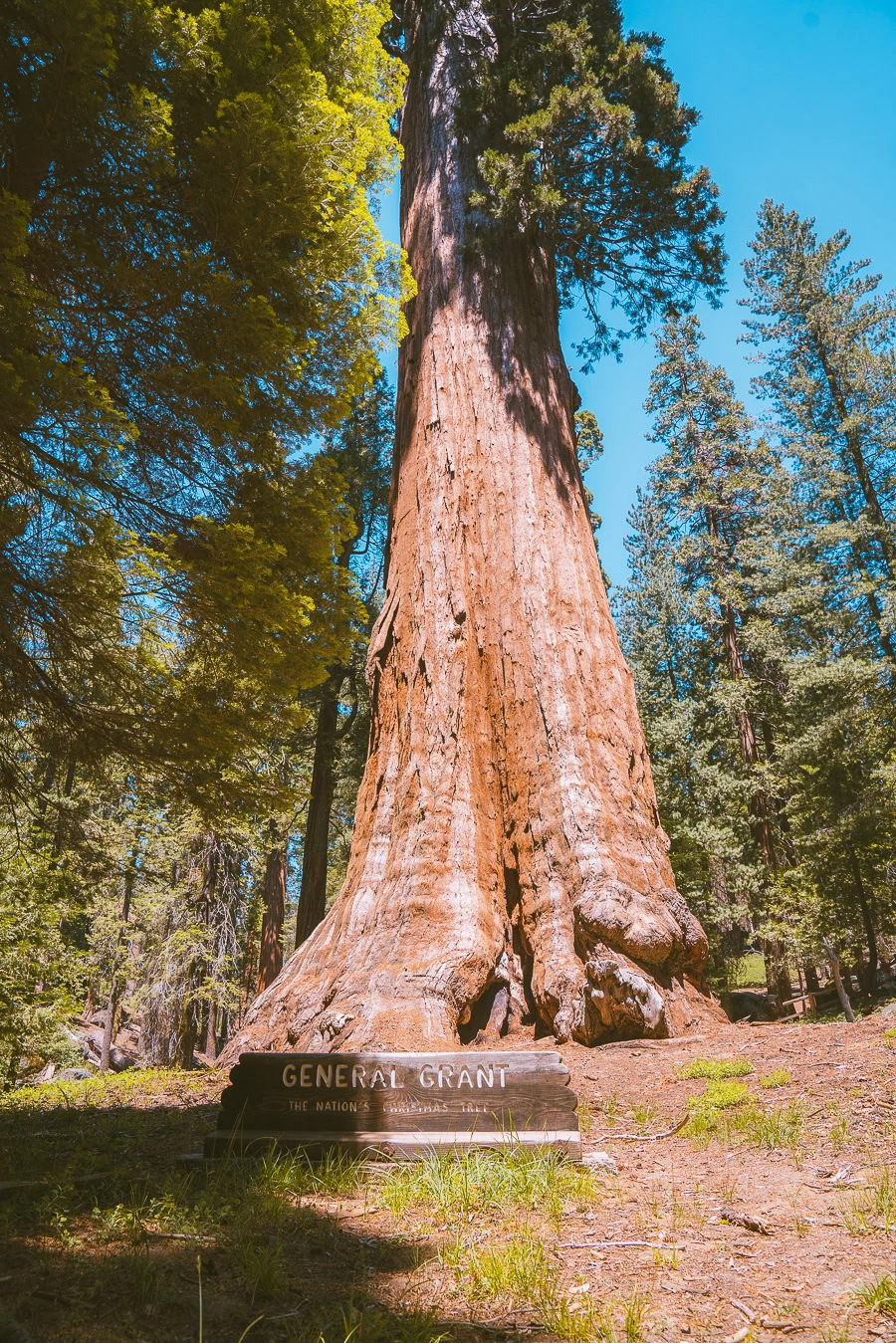
The General Grant Tree is near the Grant Grove Stables, so ending your day in Kings Canyon here makes sense. This is another colossal sequoia tree worth seeing. In fact, it’s the second-largest giant sequoia tree in the world after the General Sherman tree.
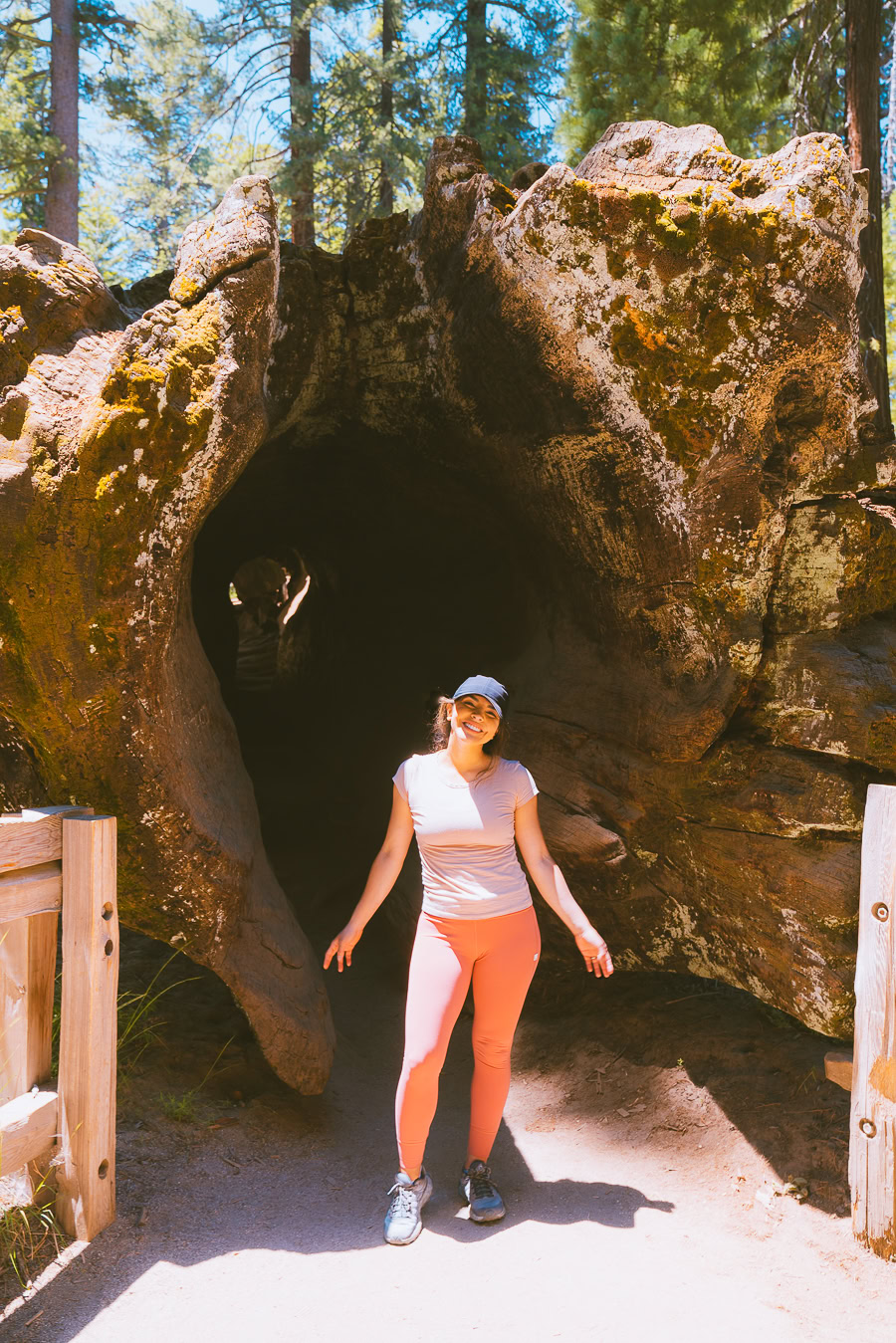
You’ll locate the Grant Tree in Grant Grove via a 14-minute paved loop trail. The tree is 268.1 feet high and has a ground circumference of 107.5 feet. Along the way, you’ll also get to meet other giants, such as the Gamlin Cabin, the Fallen Monarch, and the Centennial Stump.
Read Next: Best things to do in Kings Canyon.
Kings Canyon and Sequoia National Park Itinerary: FAQs
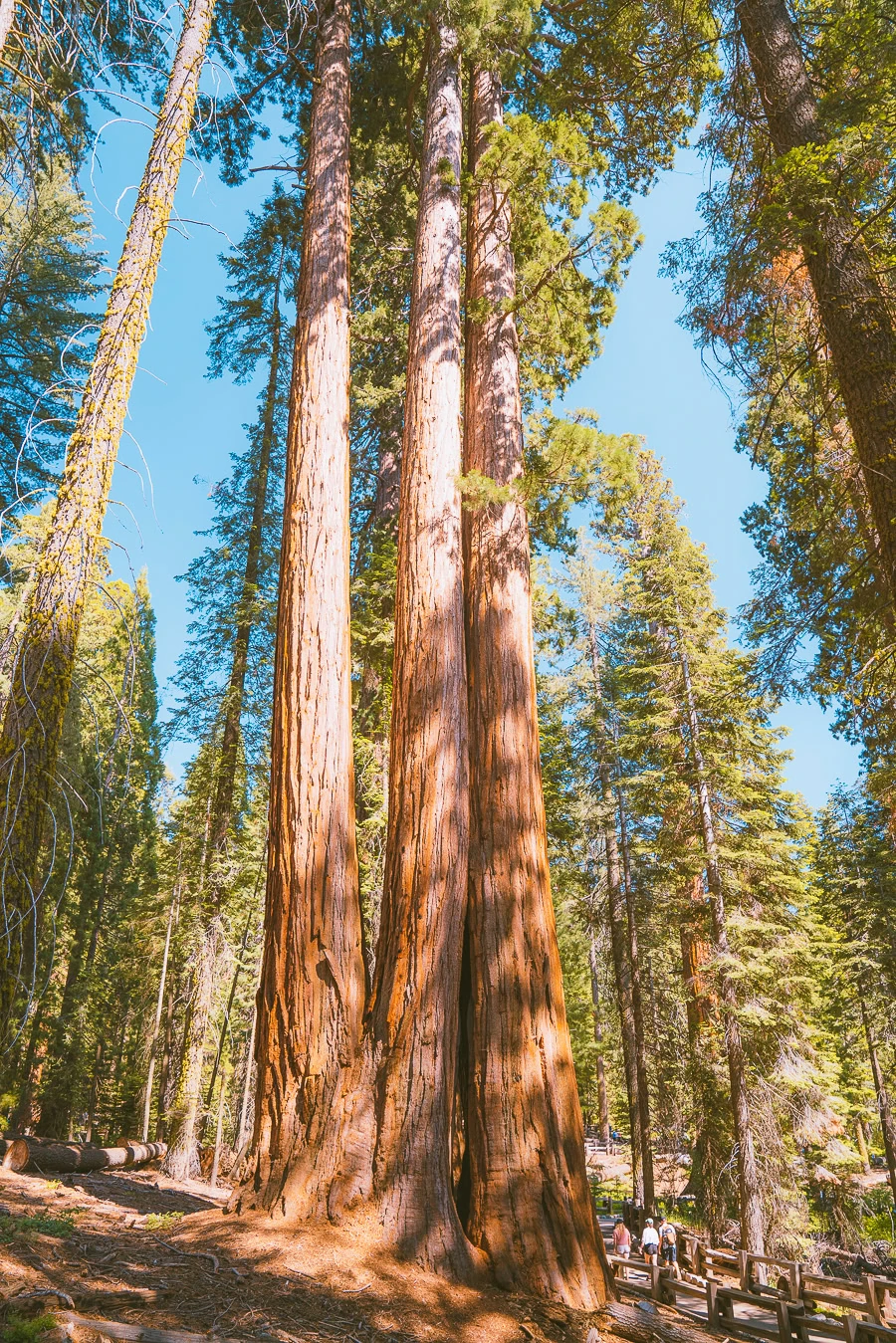
Have a look at the most frequently asked questions about Sequoia:
How Many Days in Sequoia National Park Is Enough?
Ask anyone who’s visited, and they’ll tell you that you need at least one day in Sequoia National Park. However, you should set aside two days to explore Kings Canyon as well.
Can You See Sequoia and Kings Canyon National Parks in One Day?
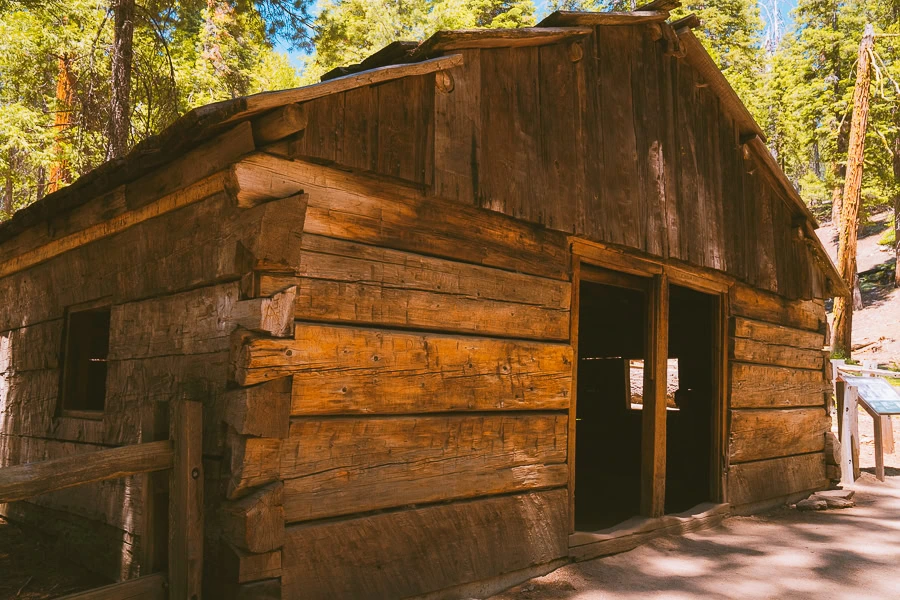
Yes. Most people plan their trip to spend one day in Sequoia and Kings Canyon National Parks. This makes perfect sense, as the two parks are only 30 miles apart if you drive from Kings Canyon’s Grant Grove to Sequoia’s General Sherman Parking area.
To sweeten the deal, you’ll drive on a scenic road, Generals Highway, that connects Sequoia and Kings Canyon for about an hour.
What Is the Closest Town to Sequoia and Kings Canyon?
The nearest town to the two parks is Three Rivers, which is roughly an hour and 10-minute drive, or 37.5 miles. Visalia is the next closest town being 45 miles away, and it’ll take you around an hour and 20 minutes to get there.
Download my free Outdoor Photography Guide
Your Sequoia Itinerary Wrapped Up
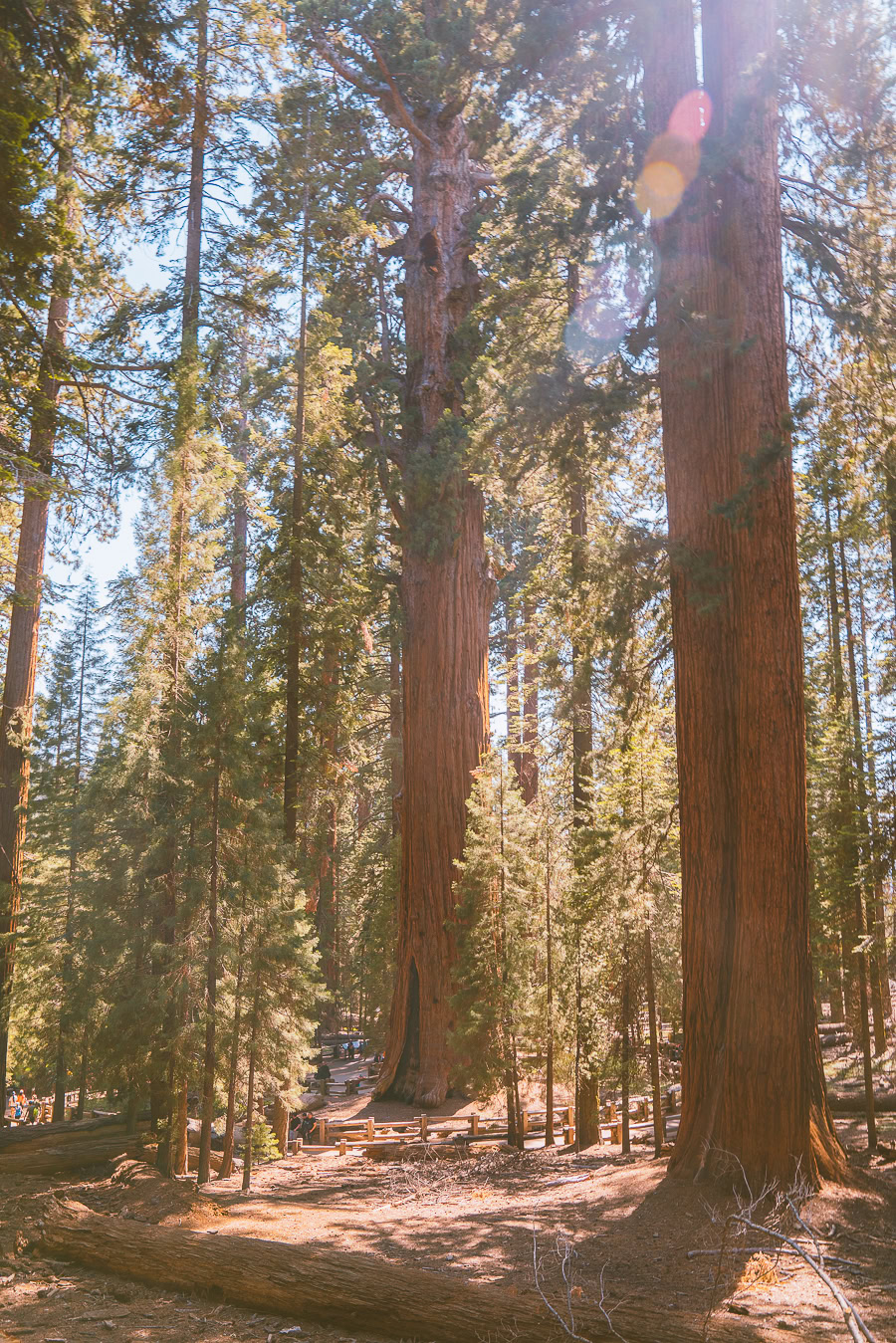
And that’s it, folks. The Sequoia and Kings Canyon deserve to be on any outdoor adventurers’ bucket list. These iconic national parks do not just offer trails, but an opportunity to truly feel close to nature and gain new perspective. And, of course, you can add more Sequoia National Park hikes to your itinerary if you have more time.
There’s truly something magical and special about being surrounded by massive, towering trees. So, go on now and discover the mighty Sequoias — mother nature is calling your name.

